Aperture's Blog, page 3
September 18, 2025
Inside the Bizarre Realm of AI Copyright Law
Spirits, monkeys, and Oscar Wilde form a strange trinity. Close your eyes and you might imagine some fin de siècle late night in a smoky room, where a blindfolded Wilde excitedly channels spirit voices. Maybe a leashed macaque looks on skeptically. Surely absinthe is being consumed. I’m guessing, however, that the US Copyright Office’s regulatory guidance on generative artificial intelligence did not find its way into your vision.
Yet somehow this triad forms the doctrinal basis for one of the most impactful and controversial sets of rules that body has promulgated in years: its guidance on how and when it will grant copyright registrations for works (including photographs) containing material generated by artificial intelligence. Wherever you might come out on that charged moral and policy question—the Copyright Office, incredibly, received more than ten thousand comments in response to its public inquiry in 2023—surprisingly little has been said of the strange, almost mystical legal precedents that the Copyright Office has relied on to develop its current position.
At its core, the question is one of authorship, and it is constitutional. The same foundational text that gave us the separation of powers allows Congress to grant intellectual property protection to “authors.” For almost one hundred and fifty years, the Supreme Court has interpreted that weighty term to limit copyright to works that “owe their origin” to the mental conceptions of a person as opposed to the mechanical reproductions of a machine.
 Screenshot from Getty Images v. Stability AI complaint, 2024
Screenshot from Getty Images v. Stability AI complaint, 2024In a leading early case from 1884, the photographer Napoleon Sarony succeeded in asserting copyright in his 1882 portrait of Oscar Wilde—but only because the photograph evidenced Sarony’s “intellectual invention.” Sarony had, according to the court, posed “Wilde in front of the camera, selecting and arranging the costume, draperies, and . . . arranging the subject so as to present graceful outlines, arranging and disposing the light and shade, suggesting and evoking the desired expression.” The court was clear, however, that this was no “ordinary” photograph, which in the usual case (without Sarony’s aesthetic sense behind it) might have remained a purely mechanical process meriting no copyright protection. Copyright, in other words, must come from the photographer and not the camera.
Despite the many decades that have passed since the obsolescence of the glass-plate negative, the case continues to speak to many of the core issues in the AI copyrightability debate. Is generative AI, like Sarony’s camera, simply a tool in the service of an artist’s skill and vision—a brush or burin for the 2020s—or is it, instead, the creator?
This leads us to the Copyright Office’s current legal test, shaped in no small part by Sarony’s precedent. When an applicant seeks to register a work containing some AI-generated material, the applicant must disclose which aspects were contributed by humans and which were not. The examiner will then decide whether the work is “basically one of human authorship, with the computer . . . merely being an assisting instrument, or whether the traditional elements of authorship in the work . . . were actually conceived and executed not by man but by a machine.’’ If the former, the Copyright Office will grant a copyright; if the latter, the work will be in the public domain for anyone to copy for any purpose.
When we call AI a black box, how different is that really from assigning agency to a spirit or the occult?
Sarony’s case is not the only precedent shaping this test. And that is where things start to get stranger. In justifying its current rules, the Copyright Office has also repeatedly pointed to a series of twentieth-century precedents involving claims over works created neither by man nor machine but by divine spirits. The leading citation here is Urantia Foundation v. Maaherra, an enigmatic case from the 1990s in which both the copyright claimant and the defendant agreed that The Urantia Book—a two-thousand-page religious text that emerged in the early twentieth century—had been written by “non-human spiritual beings” including “the Divine Counselor, the Chief of the Corps of Superuniverse Personalities, and the Chief of the Archangels of Nebadon.” Despite this spiritual baggage, the court recognized a valid copyright. While the teachings may have been divine, the court observed, a group of human interlocutors prompted the spirits to reveal those lessons and arranged the answers in a minimally creative way.
The Urantia court opinion pointed to a contrary holding from the 1940s in which the copyright claimant characterized himself as merely the amanuensis to whom a text was dictated by “Phylos, the Thibetan, a spirit.” That copyright assertion, unlike the one in Urantia, was rejected because the human scribe had claimed protection in the divine revelations themselves as opposed to any human arrangement of them. You can prompt the cosmos and remain a copyright author, it would seem, but straight transcription damns the work for all eternity.
 David Slater, Monkey Selfie, 2011
David Slater, Monkey Selfie, 2011
© the artist and courtesy Caters Media Group
Better known than Urantia, but equally esoteric in its facts, is Naruto v. Slater, a litigation literally brought by a seven-year-old crested macaque against the wildlife photographer David Slater. Naruto the monkey, who had taken a few selfies with a camera left around by Slater, naturally took umbrage at seeing copies of his work reproduced without permission and saw fit (with a little help from People for the Ethical Treatment of Animals) to sue Slater for copyright infringement. Suffice it to say, the monkey’s case was thrown out of federal court because copyright infringement remains a claim viable only to humans.
To be clear, these are not incidental, one-off citations by the Copyright Office. The government relied on Urantian revelations to support its position on AI-generated content in, for instance, its official statement of policy in its formal federal regulations, every one of its four published registration decisions in the AI section of its website, its official compendium of registration practices, its recent extended report on Copyright and AI, and its extensive appellate briefing on the leading case in this area, Thaler v. Perlmutter.
At this point, you may be wondering how exactly the Copyright Office is applying these extraordinary precedents to everyday copyright claims in the AI space. Take as an example the recent attempt by Ankit Sahni to register SURYAST (ca. 2021), a work that was essentially a mash-up of a source photograph taken by Sahni of a sunset with Vincent van Gogh’s The Starry Night (1889). Sahni inputted into an AI-powered tool known as RAGHAV a base image (his original sunset photograph), a style image (The Starry Night, which is in the public domain), and a value to determine the strength of the style transfer for the tool to use. RAGHAV then generated the final work without, we are told, further modification or input from Sahni.
The Copyright Office rejected the application. Despite the fact that the source photograph was taken by Sahni (and likely copyrightable on its own), it concluded that “the RAGHAV app, not Mr. Sahni, was responsible for determining how to interpolate the base and style images in accordance with the style transfer value. The fact that the Work contains sunset, clouds, and a building are the result of using an AI tool.” On what legal authority? It turned, naturally, to our cases on Oscar Wilde, the chief of the archangels of Nebadon, and a crested macaque.
 Ankit Sahni, SURYAST, ca. 2021
Ankit Sahni, SURYAST, ca. 2021 Vincent van Gogh, The Starry Night, 1889
Vincent van Gogh, The Starry Night, 1889
© The Museum of Modern Art/Licensed by SCALA/Art Resource, NY
What should we make of the fact that in setting critical policies for a truly paradigm-shifting technology, the Copyright Office is comparing generative artificial intelligence to a nineteenth-century albumen-silver print, revelatory channeling, and monkey selfies? Analogic legal reasoning, the core process by which common law develops through the selection and analysis of like precedents, inevitably involves some leaps. The rules governing digital music distribution were derived from cases on flea markets, the Sony Betamax, and the player piano before that.
We will naturally see this methodology at work soon as US courts start deciding the so-called ingestion photography cases (the negative, if you will, of the copyright registration authorship debate described above). Take, for instance, the photographer Jingna Zhang’s 2024 suit against Google, now consolidated into an even larger litigation, accusing the company of directly copying her photographs, without permission, for use in training Google’s Imagen text-to-image diffusion model. Or look to the recently refiled version of the case Getty Images v. Stability AI, in which Getty has accused Stability AI of not only copying twelve million Getty images to train its original Stable Diffusion model but allowing for the regeneration (in a somewhat grotesque form) of modified versions of those images as outputs.
Barring any settlement, both claims are likely to hinge on the fair use defense, with key precedents ranging from Lynn Goldsmith’s victory over the Andy Warhol Foundation for the Visual Arts in 2023 to Google’s own successful assertion of fair use in defense of its Google Books initiative ten years ago. As we have seen in a handful of issued opinions this summer in AI cases involving the ingestion of books, these suits might turn on a simple choice between two metaphors: Is ingesting countless copyright-protected photographs into a dataset, and using that set to train Imagen or Stable Diffusion, more like the Warhol Foundation’s commercialization of unlicensed derivative illustrations to compete in the same market as Goldsmith’s original artist reference photograph (not fair use), or more like the volume scanning of every book ever to create a searchable corpus of the world’s literature (fair use)?
Still, there needs to be a core logic to any legal metaphor, particularly when the stakes are as high as they are: a technology poised to overtake so much creation. We can intuit why a court in these ingestion cases might compare the training of text-to-image AI software to either using a photograph without permission to create competing works or to the digitization of millions of books.
But the Copyright Office precedents on copyright authorship look to far more distant realms. Although the otherwise staid body would certainly deny it, there is something bordering on mystical in the government’s position. By relying on supernatural precedents, it is inherently assigning a spiritual ineffability to the AI-generative process. It is effectively stating that when photographers upload a source image to a generative AI program such as Midjourney, they are closer to animal or medium than artist.
Related Items
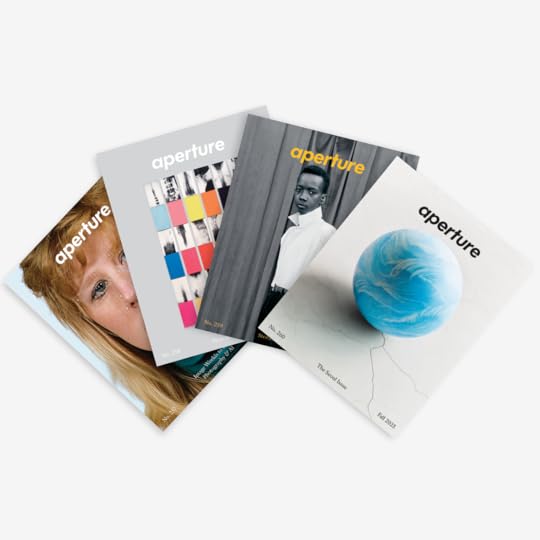
Aperture Magazine Subscription
Shop Now[image error]
What Is Realism in the Age of AI?
Learn More[image error]Not that this mysticism is necessarily unfounded. Almost every thoughtful account of generative artificial intelligence concedes, at a certain point, that its own developers really cannot explain or account for any given output from the tool. When we call AI a black box, how different is that really from assigning agency to a spirit or the occult? Aren’t we effectively attributing authorship to the ghost in the machine either way? The human is merely prompting the unknown in both cases, in every sense of that verb.
Andrew Ventimiglia, the author of an exemplary study of the Urantia cases, pushes the analogy even further, arguing that such precedents show how the physical objects of intellectual property—the hard-copy Urantia Book or Naruto’s, Sarony’s, or Sahni’s photographs—themselves “assert a kind of ghostly ontology.” That is, they are imbued by virtue of their litigation histories with the aura and spirit of law and the almost supernatural threat of copyright enforcement should one reproduce them.
However compelling these metaphysical analogies, though, copyright policy has real consequences on the ground. Whether and how we grant century-long monopolies in content has tangible stakes for countless people (including the many photographers reading this) and entire industries. It seems borderline absurd that we would build such monumental AI policy choices on a foundation of arcane precedents adjudicating the copyrightability of the aesthetics of Victorian photography, divine revelations, and the standing of monkeys.
I don’t mean to suggest that the Copyright Office has acted improperly here. That body is not empowered simply to create new rules out of whole cloth. It can only weave together the collection of opinions it has been handed by the federal courts, however crazy a quilt might result.
What this instead reveals is another limitation of the slow, rear-facing, and too-often nonrational development of our copyright doctrine. Confronted with a groundbreaking technology our copyright administrators are left divining old, mystic texts rather than asking straightforwardly what the best rule would be to incentivize some desirable outcome.
All that said, it remains fair to request, at the very least, that the Copyright Office shape its guidance on generative AI with a view more toward this world than the next.
A version of this article originally appeared in Aperture No. 257 “Image Worlds to Come: Photography & AI.”
Photographing the Night That Shook Seoul
In the midday sunlight of upstate New York, I had no way of knowing how cold the night of December 3, 2024, was in South Korea, how dark and long it had been. With a fourteen-hour time difference, martial law in South Korea felt incomprehensible to me, like seeing the future of my homeland. But for the Seoul-based photographer Yezoi Hwang, it was the present. The words martial law, heard while having dinner, communicated something she couldn’t believe without seeing with her own eyes. So she picked up her camera and went out into the square.
Hwang often uses her camera in an effort to understand the incomprehensible. After making series that focused on her family—capturing, for example, stories of conflict and reconciliation in Season (2016)—she gradually redirected her lens toward people on the margins, people who often bear invisible wounds. She developed a gaze of care, and as a result could see more clearly that she lived in a fragmented society masked by a fantasy of unity. Flashback Diary (2024–25) is Hwang’s documentary photography series of the protests from the moment former President Yoon Suk Yeoul declared martial law to his eventual impeachment.


Hwang witnessed: While men clashed with their bodies and raised their voices in combative protest, middle-aged women stood at the front lines to protect younger women. The uniforms of the police blocking the National Assembly and confronting the protesters failed to absorb light, reflecting it instead, turning them into ghosts. In contrast, hopeful handwritten notes, ribbons, and tiny, solidaristic snowmen became fixtures of the cityscape. So did the voices of countless women beyond the frame, through whom Hwang discovered what care truly means. And just like the lines in Theresa Hak Kyung Cha’s 1982 novel Dictee that the artist continually returned to, it was “MAH-UHM,” the spirit: “It is burned into your ever-present memory. Memory less. Because it is not in the past. It cannot be. Not in the least of all pasts. It burns. Fire alight enflame.”
 Aperture Magazine Subscription 0.00 Get a full year of Aperture—the essential source for photography since 1952. Subscribe today and save 25% off the cover price.
[image error]
[image error]
Aperture Magazine Subscription 0.00 Get a full year of Aperture—the essential source for photography since 1952. Subscribe today and save 25% off the cover price.
[image error]
[image error] 
In stock
Aperture Magazine Subscription $ 0.00 –1+ View cart DescriptionSubscribe now and get the collectible print edition and the digital edition four times a year, plus unlimited access to Aperture’s online archive.
Only seven years after the Korean War armistice, Koreans rose up in the April 19 Revolution of 1960, under martial law, to oppose the fraudulent election and dictatorship of the Syngman Rhee regime. In the October Restoration of 1972, former President Chung-hee Park imposed martial law to replace democracy with authoritarian rule in South Korea. In 1980, the Gwangju Uprising erupted in resistance to Doo-hwan Chun’s coup and the imposition of martial law, leading to mass killings. Martial law was present at every major political turning point in the country’s history. Because it granted “special measures” over freedom of the press, publication, assembly, and association, martial law was used as a tool for the government to wield coercive power over the basic rights of the people. It left indelible, inherited scars. A foreign journalist once said that democracy blooming in Korea is as unlikely as a rose sprouting from a trash can. Yet Koreans never hesitated to bleed red if it meant that rose might bloom. For more than sixty years, the people of Korea have protected that rose; the sudden reemergence of martial law was tantamount to its trampling.
To Hwang, the photographs in Flashback Diary are not a record of fear and violence. What she aimed to record with her camera was the strength of invisibles—those who built fortresses of warmth and hospitality against violence, and brought about a slow but democratic victory. The images act as a memoir of the artist as an autonomous woman engaging in dialogue with the social unrest surrounding her. As Hwang told me, “Photography becomes a tool that allows one individual to confront the multitude.” Her lens became a shield against a precarious world, and the resulting photographs became a fiercely burning “MAH–UHM” she carries, ever present.







 All photographs Yezoi Hwang, Flashback Diary, 2024–25
All photographs Yezoi Hwang, Flashback Diary, 2024–25Courtesy the artist
This article originally appeared in Aperture No. 260, “The Seoul Issue.”
Photographing the Night that Shook Seoul
In the midday sunlight of upstate New York, I had no way of knowing how cold the night of December 3, 2024, was in South Korea, how dark and long it had been. With a fourteen-hour time difference, martial law in South Korea felt incomprehensible to me, like seeing the future of my homeland. But for the Seoul-based photographer Yezoi Hwang, it was the present. The words martial law, heard while having dinner, communicated something she couldn’t believe without seeing with her own eyes. So she picked up her camera and went out into the square.
Hwang often uses her camera in an effort to understand the incomprehensible. After making series that focused on her family—capturing, for example, stories of conflict and reconciliation in Season (2016)—she gradually redirected her lens toward people on the margins, people who often bear invisible wounds. She developed a gaze of care, and as a result could see more clearly that she lived in a fragmented society masked by a fantasy of unity. Flashback Diary (2024–25) is Hwang’s documentary photography series of the protests from the moment former President Yoon Suk Yeoul declared martial law to his eventual impeachment.


Hwang witnessed: While men clashed with their bodies and raised their voices in combative protest, middle-aged women stood at the front lines to protect younger women. The uniforms of the police blocking the National Assembly and confronting the protesters failed to absorb light, reflecting it instead, turning them into ghosts. In contrast, hopeful handwritten notes, ribbons, and tiny, solidaristic snowmen became fixtures of the cityscape. So did the voices of countless women beyond the frame, through whom Hwang discovered what care truly means. And just like the lines in Theresa Hak Kyung Cha’s 1982 novel Dictee that the artist continually returned to, it was “MAH-UHM,” the spirit: “It is burned into your ever-present memory. Memory less. Because it is not in the past. It cannot be. Not in the least of all pasts. It burns. Fire alight enflame.”
 Aperture Magazine Subscription 0.00 Get a full year of Aperture—the essential source for photography since 1952. Subscribe today and save 25% off the cover price.
[image error]
[image error]
Aperture Magazine Subscription 0.00 Get a full year of Aperture—the essential source for photography since 1952. Subscribe today and save 25% off the cover price.
[image error]
[image error] 
In stock
Aperture Magazine Subscription $ 0.00 –1+ View cart DescriptionSubscribe now and get the collectible print edition and the digital edition four times a year, plus unlimited access to Aperture’s online archive.
Only seven years after the Korean War armistice, Koreans rose up in the April 19 Revolution of 1960, under martial law, to oppose the fraudulent election and dictatorship of the Syngman Rhee regime. In the October Restoration of 1972, former President Chung-hee Park imposed martial law to replace democracy with authoritarian rule in South Korea. In 1980, the Gwangju Uprising erupted in resistance to Doo-hwan Chun’s coup and the imposition of martial law, leading to mass killings. Martial law was present at every major political turning point in the country’s history. Because it granted “special measures” over freedom of the press, publication, assembly, and association, martial law was used as a tool for the government to wield coercive power over the basic rights of the people. It left indelible, inherited scars. A foreign journalist once said that democracy blooming in Korea is as unlikely as a rose sprouting from a trash can. Yet Koreans never hesitated to bleed red if it meant that rose might bloom. For more than sixty years, the people of Korea have protected that rose; the sudden reemergence of martial law was tantamount to its trampling.
To Hwang, the photographs in Flashback Diary are not a record of fear and violence. What she aimed to record with her camera was the strength of invisibles—those who built fortresses of warmth and hospitality against violence, and brought about a slow but democratic victory. The images act as a memoir of the artist as an autonomous woman engaging in dialogue with the social unrest surrounding her. As Hwang told me, “Photography becomes a tool that allows one individual to confront the multitude.” Her lens became a shield against a precarious world, and the resulting photographs became a fiercely burning “MAH–UHM” she carries, ever present.







 All photographs Yezoi Hwang, Flashback Diary, 2024–25
All photographs Yezoi Hwang, Flashback Diary, 2024–25Courtesy the artist
This article originally appeared in Aperture No. 260, “The Seoul Issue.”
September 11, 2025
Heinkuhn Oh’s People of the Twenty-First Century
Heinkuhn Oh rose to prominence with his photographs of social types—high school students, cosmetic girls, soldiers—often printed at gargantuan scale. Their faces greet visitors to Oh’s airy studio in southern Seoul. Uncanny, at times disarming expressions hint at the layered ambiguity present throughout his work. Although Oh’s portraits emerged from discrete series dedicated to groups, each subject’s eccentricities break through such categories, subtly dramatizing tensions between collective and personal identity in Korean society.
Oh’s early work was informed by his ambition to become a filmmaker and his years living and traveling in the United States. Equally influential was his experience growing up in Itaewon, a neighborhood in Seoul that was once a roiling tenderloin whose nightclubs and brothels catered to US soldiers. Today, it is one of the city’s trendiest neighborhoods, with bustling cafés, chic boutiques, and roaming influencers. Oh’s breakthrough series, Itaewon Story (1993), is a pregentrification tale, capturing the vivid underground characters who once defined the area. He has described Itaewon as a kind of in-between zone, a space “where people exist between cultures—neither fully one thing nor another.” It is a description that could be applied to Oh’s work as well, where his subjects often reside in liminal states: between the mainstream and the margins, childhood and adulthood, the individual and the collective, fiction and reality.
 Heinkuhn Oh, Love Cupid Bar, on the Hill of Lucky Club, March 1993, from the series Itaewon Story
Heinkuhn Oh, Love Cupid Bar, on the Hill of Lucky Club, March 1993, from the series Itaewon Story  Heinkuhn Oh, Two Ajummas 1, March 26, 1997, from the series Ajumma
Heinkuhn Oh, Two Ajummas 1, March 26, 1997, from the series Ajumma Hyunjung Son: For readers new to your work, could you tell us about your background and what drew you to photography?
Heinkuhn Oh: Originally, my dream was to become a film director. I went to the United States to study filmmaking, but along the way, I fell in love with photography—more precisely, with documentary photography. I ended up going to graduate school and majoring in photography, but near the end, I still felt something was missing, so I added film as a second major. However, I ultimately received my final degree only in photography. I became so absorbed in my thesis project, Americans Them, that I didn’t have the time or energy to complete a film thesis. My mind was filled with the work of Garry Winogrand and Diane Arbus. Honestly, it was far more exciting to me than anything from Scorsese or Coppola.
From 1989 to 1991, I spent three crazy years traveling across cities in Ohio, West Virginia, and Illinois for Americans Them. Eventually, I made my way south to New Orleans. The camera I used back then was a fifty-year-old secondhand Speed Graphic, which I bought from a used-camera shop in Columbus. I attached a Metz flash to it and shot with 4-by-5-inch Type 55 Polaroid film. I felt like I had become Weegee. Initially, I used the camera’s range finder, but later, I started shooting everything by eye measurement. Although many shots came out of focus, not using the viewfinder made me look at my subjects with my naked eyes. It was a wonderful thing. These days, as I’m reprinting Americans Them, I realize just how much I learned about people and their gazes through that project.
Son: This word gaze comes up often when describing your work. You’ve said you discover, rather than create, these gazes.
Oh: In the late 1990s, I wanted to document the anxiety and social isolation experienced by middle-aged women in Korea, which was very much a country of ajeossi [middle-aged men]. This led me to photograph ajumma [middle-aged women]. Instead of taking the documentary approach I might have used earlier, I went directly to portraits. I had realized that if I could capture the narrative in their gazes and expressions, no further explanation was needed.
Creating a multilayered gaze artificially is impossible. These layers accumulate naturally through lived experience, visible in people’s expressions. The process of finding such gazes is time intensive. For my series Ajumma (1997), while the actual photography took less than two months, the casting period took over a year. I’ve done a lot of movie poster work as well, so I’ve sometimes been asked questions about the gaze of celebrities versus ordinary people. One question I received was, “What is the difference between the gaze of actors and that of ordinary people in your work?” With actors, I work to create layers in their gazes, while with ordinary people, I discover the layers already present in their expressions.
It was the same with my Cosmetic Girls (2005–8) project. From 2005 to 2007, I cast around five hundred heavily made-up teenage girls directly from the streets. Over the course of three years, I photographed one or two of them each day, and from those portraits, I looked for the gazes that carried the deepest layers of anxiety. This is because I believed that for these girls, makeup was an act of concealing their anxiety.
 Aperture Magazine Subscription 0.00 Get a full year of Aperture—the essential source for photography since 1952. Subscribe today and save 25% off the cover price.
[image error]
[image error]
Aperture Magazine Subscription 0.00 Get a full year of Aperture—the essential source for photography since 1952. Subscribe today and save 25% off the cover price.
[image error]
[image error] 
In stock
Aperture Magazine Subscription $ 0.00 –1+ View cart DescriptionSubscribe now and get the collectible print edition and the digital edition four times a year, plus unlimited access to Aperture’s online archive.
Son: Your use of the term casting is interesting, coming from your film background. How do you actually find and photograph your subjects?
Oh: My approach mirrors film casting because I believe great directors don’t so much direct actors as find the right people for each role. Once cast properly, actors naturally embody their characters. Similarly, I don’t try to create complex gazes—I find people who naturally possess them. My role then becomes creating the trust needed for them to reveal their authentic selves to the camera. That’s often the most challenging part.
Son: You’ve done a lot of commercial photography, including the movie posters you mentioned. How did you start this work?
Oh: In fact, all of my early black-and-white works are closely tied to my film background. Even Americans Them was fundamentally about capturing Americans as they appeared to be performing their lives as if in films—playing out cinematic storytelling or role-playing characters from movies. It seemed to me that they dressed, posed, and even joked as if they were in a film. It often reminded me of the movies by the Coen brothers. Itaewon Story was like an autobiographical film for me, capturing the images of celebrities I grew up watching in Itaewon during my childhood.
 Heinkuhn Oh, A T-50A training jet with its pilot in the cockpit, July 2010, from the series Middlemen
Heinkuhn Oh, A T-50A training jet with its pilot in the cockpit, July 2010, from the series Middlemen  Heinkuhn Oh, Two honor guards wearing black formal dress, July 2010, from the series Middlemen
Heinkuhn Oh, Two honor guards wearing black formal dress, July 2010, from the series Middlemen Son: Your series Middlemen (2010–13) features military portraits, but I heard it was originally titled Absurd Play. Why did you change it?
Oh: In Korea, there is a mandatory system where most men serve in the military for a certain period. I, too, went to the military through this system when I was young, and after time passed, I came to look at that space again through photography. I completed my military service about thirty years ago. As a young man, my view of military service was straight-forward—it was about patriotism and duty. Returning to photograph the military in my fifties, everything appeared strange and awkward. The experience felt like watching an absurd play unfold, which inspired the original title. However, two months before the exhibition, our cultural liaison officer at the Ministry of National Defense privately expressed concern. The higher-ups had reacted negatively to the word absurd, interpreting it as suggesting something dysfunctional or improper. To protect our helpful liaison, I changed the title to Middlemen.
The work became subtitled Portraits of Young Korean Soldiers. During my two years observing these men, I recognized how they existed in a liminal state—neither fully civilian nor completely military. This realization led to the title Middlemen. It also sparked my broader interest in exploring these in-between states in society and, by extension, the nature of absurdity itself.
I don’t try to create complex gazes—I find people who naturally possess them.
Son: Would you share how you created works like the fighter pilot photographs?
Oh: For most of the photographs in my Middlemen project, the shooting process wasn’t particularly difficult. I didn’t try to capture or request any scenes that the military might find sensitive or uncomfortable. However, there was always a cultural liaison officer monitoring the images on a laptop connected to my camera—essentially conducting censorship. They said it was to prevent any accidental capture of military secrets, but I think they were really worried I might show something negative about the military. After a while, the officer even joked, “Why are you taking such boring pictures?”
But the fighter pilot shot was one that gave me a lot of trouble, even with this kindhearted liaison officer. The problem arose when I asked them to briefly halt a fighter jet during an operation. I thought they could simply stop it on the runway for a moment, not realizing that a fighter jet isn’t an automobile and costs tens of millions of dollars. Moreover, this was a military operational area, and stopping on the runway required approval from multiple levels of command. Eventually, the approval came through, and they did stop the jet, but the photography session took longer than expected. The officer kept pressuring me to hurry because the operation was ongoing, and the pilot was becoming increasingly irritated. What I found most interesting in this photograph, though, wasn’t the huge fighter jet or the pilot—it was the transparent canopy, stretching wide and open into the sky.
There was an incident that I couldn’t capture in a photograph, but even now, it remains with me like a trauma. During a shoot, I suddenly heard a sharp, piercing scream from behind me. When I quickly turned around, I saw something wrapped in a white cloth falling through the air. A soldier had jumped from an open window, from about the fifth floor of a building behind me. Tragically, I later heard that he had died. Military officials told me that the soldier had been suffering from severe depression, and that such incidents, while uncommon, did occur in the military.
 Heinkuhn Oh, Four soldiers before a mock cavalry battle, May 2010, from the series Middlemen
Heinkuhn Oh, Four soldiers before a mock cavalry battle, May 2010, from the series MiddlemenSon: Your exhibition prints, including the Middlemen series, are often very large in scale. Why?
Oh: Starting with my Cosmetic Girls series, which I released in 2008, the scale of my work began to expand. There are two techniques in typological photography that can shift the subject toward abstraction: One is repetition, and the other is scale.
Cosmetic Girls was a portrait project that presented heavily made-up teenage girls in a format resembling a social report. The expressionless gazes of different girls were captured under identical lighting and with consistent framing, repeated again and again. At first, it may seem like each girl is being presented individually and concretely, but ultimately, through repetition, the images dissolve into abstraction.
I believe that when a photograph becomes excessively large, the subject itself begins to feel unfamiliar. This is one of the great ironies of large-scale photography. Especially in portraiture, the bigger the print, the more anonymous the subject becomes. I wanted the girls I photographed to appear anonymous and estranged. Because, for me, the series is ultimately about the underlying anxiety surrounding identity in Korean society that stems from feelings of anonymity, estrangement, disappearance, and abstraction.
In my more recent series, Left Face (2020–ongoing), the prints are also relatively large. But this time, the reason is slightly different. Lately, I’ve gotten interested in how large photographs create abstraction through their very obviousness. I think big photographs have this interesting thing where they switch between being clear and abstract. Having spent many years working in photography, I’ve started to feel that photography isn’t really about representation—it’s about abstraction, simply because it’s too obvious and straightforward.
Advertisement
googletag.cmd.push(function () {
googletag.display('div-gpt-ad-1343857479665-0');
});
Son: You’ve contrasted your philosophy with Henri Cartier-Bresson’s famous idea of the “decisive moment” by telling your students, “Don’t be decisive.”
Oh: Cartier-Bresson’s “decisive moment” refers to visual rather than conceptual decisiveness. However, I’ve come to believe that our contemporary world resists such clean distinctions. If photography reflects society, and society increasingly defies logical categorization, then perhaps photography should embrace this ambiguity. That’s why I tell my students, “Don’t be decisive.” Definitive statements and clear conclusions feel increasingly out of step with reality. When everything exists in shades of gray, why chase decisive moments? Even Cartier-Bresson often captured scenes that highlighted life’s fundamental absurdity.
Son: You have taught photography for many years. How has this shaped your thinking on image making?
Oh: Well, I’ve always tried to approach my students as an artist rather than as an educator. Observing the younger generation of photographers today, I feel they have highly developed visual sensibilities. But perhaps that’s only natural, as they consume so many more images than previous generations. During critique sessions, I often tell my students, “You are image addicts!” It’s as if they confuse reality and images. Today’s students look at reality and capture it as images, then look at images and discuss them as reality. While there’s nothing inherently wrong with this approach, I wish they could distinguish between the two.
 Heinkuhn Oh, Huh jung, 20080428, 2022, from the series Left Face
Heinkuhn Oh, Huh jung, 20080428, 2022, from the series Left Face  Heinkuhn Oh, JU, 20160716, 2022, from the series Left Face
Heinkuhn Oh, JU, 20160716, 2022, from the series Left Face Son: Your early 1990s series Itaewon Story continues to resonate today. What makes it significant to you?
Oh: Itaewon has been my home since I was six years old. During my childhood in the ’60s and ’70s, Itaewon was dominated by the US Eighth Army presence and was known as a “camp town.” The alley near the fire station where my family lived was specifically designated as a “red-light district” under special administrative management. Because of that, there were lots of nightclubs and bars catering to American soldiers, and US goods smuggled out of the military base were everywhere. From an early age, I was exposed to drunken American GIs and Korean women working in the entertainment districts. I also got along well with waiters and waitresses who worked in the clubs and bars. Later, when I entered middle and high school and met friends who had more typical, ordinary childhoods, I realized that I had grown up in a very different environment. For a time, those early experiences became a kind of trauma for me, and a major source of insecurity. Itaewon Story explores these memories and the characters who populated them, including entertainers like Twist Kim and Shin Canaria, who were either familiar faces or local legends during my childhood.
Related Stories Portfolios Heinkuhn Oh’s Vivacious Portrait of Seoul in the 1990s
Portfolios Heinkuhn Oh’s Vivacious Portrait of Seoul in the 1990s Though the US Eighth Army has relocated, Itaewon remains a unique cultural space. The Seoul Central Mosque, situated at the neighborhood’s highest point, has drawn a significant Arab community, adding to the area’s diverse mix of residents. Yet calling Itaewon truly multicultural might be an overstatement. Different groups coexist physically but rarely truly integrate. This makes it a place where people exist between cultures—neither fully one thing nor another. It’s fitting that Itaewon sits geographically at Seoul’s center, embodying this in-betweenness. Sometimes I wonder if this fascination with in-between states is my destiny—the space between cultures, between definitions, between artistic forms.
Son: Photography seems to be gaining more recognition in Korea’s art world. What changes have you observed? And what concerns you as a photographer?
Oh: The landscape has definitely improved. More exhibition opportunities exist now, and major institutions increasingly embrace photography as contemporary art. We’re seeing more photography exhibitions in prestigious venues and more international exchange. However, I still maintain that there’s a distinction between photography within art and photography as its own medium. While this might seem like an outdated view in today’s cross-disciplinary art world, I believe photography maintains its own singular territory. We have plenty of discussions about photography in terms of aesthetics and social impact, but I miss deeper conversations about the fundamental elements that make photography unique as a medium.
Son: What directions are you exploring now? And what’s next for your work?
Oh: My immediate focus is completing Left Face, a project that has occupied the past five years. Its scope has grown beyond my initial expectations, and I’m still working to bring all the elements together.
I’m currently exploring the intersection of photography and text, but not in the usual documentary sense. I’m exploring how combining highly specific text with portraits can create a new kind of abstraction. I’m also planning to return to Itaewon for a new portrait series. The title is already decided—it’s Lucky Club. It will probably be work about various people living together in an old building in Itaewon. There, I need to find gazes that contain stories once again.
Son: Seoul is changing rapidly today. What’s your attitude toward the city’s development?
Oh: It’s absurd. This was a title I couldn’t use for the Middlemen project, but if I were to address Seoul as a subject, I would want to use it—a massive “absurd play” is unfolding here. Some describe Seoul’s transformation as diverse and dynamic, but I find it contextless and absurd. Yet photographically, I feel that’s what makes Seoul fascinating. Sometimes I find myself wondering if I should pick up my Speed Graphic again and head back out to the streets to shoot a documentary like Americans Them. I’ll need to think about whether it would become Koreans Them or Koreans We . . .
This interview originally appeared in Aperture No. 260, “The Seoul Issue.”
September 5, 2025
11 Exhibitions to See This Fall
 Don McCullin, Catholic youths escaping from CS gas, Londonderry, Northern Ireland, 1971
Don McCullin, Catholic youths escaping from CS gas, Londonderry, Northern Ireland, 1971Courtesy the artist and Hauser & Wirth
Don McCullin – New York
A Desecrated Serenity charts seven decades of Don McCullin’s photojournalistic work across conflicts in Greece, Vietnam, Biafra, Bangladesh, Northern Ireland, and Beirut. The exhibition, his first New York show at Hauser and Wirth, presents his harrowing portraits and reportage from the front lines alongside cherished objects—like the Nikon F camera that once caught a stray bullet during battle. The exhibition moves from the stark landscapes of crime and poverty in postwar Britain; through unflinching records of global conflict; to images of vibrant cultural rituals in India, Indonesia, and the Sudan; to painterly meditations on the countrysides of France, Scotland, and Somerset, where McCullin sought solace late in his career.
Don McCullin: A Desecrated Serenity at Hauser & Wirth, through November 8, 2025.
 Tyler Mitchell, New Horizons II, 2022
Tyler Mitchell, New Horizons II, 2022© the artist and courtesy Gagosian
Tyler Mitchell – Paris
Growing up in a suburb of Atlanta, Georgia, Tyler Mitchell made skateboarding videos inspired by Spike Jonze and Ryan McGinley. After enrolling at New York University with plans to become a filmmaker, he began to make portraits full of energy, brash color, and sartorial panache, honing a signature look that landed him commissions for i-D and Vogue. This fall, Mitchell’s exhibition Wish This Was Real arrives in Paris after stops in Berlin, Helsinki, and Lausanne, Switzerland. Covering roughly a decade of image making, the show offers new perspectives on his abiding themes of masculinity, joy, and beauty. As the critic Salamishah Tillet writes in an accompanying monograph published by Aperture, “Mitchell’s work brilliantly reconceptualizes familiar spaces and teaches us that Black utopia has always been a place, constantly moving, unfolding, and being remade—like freedom.”
Tyler Mitchell: Wish This Was Real at the Maison Européenne de la Photographie, Paris, October 15, 2025–January 25, 2026
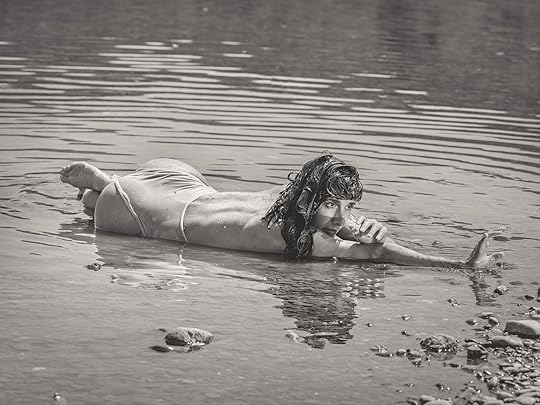 Katy Grannan, Damla, Mad River, CA, 2025
Katy Grannan, Damla, Mad River, CA, 2025© the artist and courtesy Fraenkel Gallery, San Francisco
Katy Grannan – San Francisco
California’s Humboldt County is considered a place where people go to disappear. Katy Grannan first came to this bucolic backcountry in 2023 and began making portraits of people she found through Craigslist ads, flyers, and eventually word of mouth. Known for building long-term relationships with her subjects, Grannan conspired with those she photographed to create a kind of collaborative fiction, working both in the studio and in nature to thread together connections between site and self. Mad River unites these portraits for the first time, offering an intimate glimpse of the independent spirit of Humboldt County’s inhabitants.
Katy Grannan: Mad River at Fraenkel Gallery, New York, through October 25, 2025.
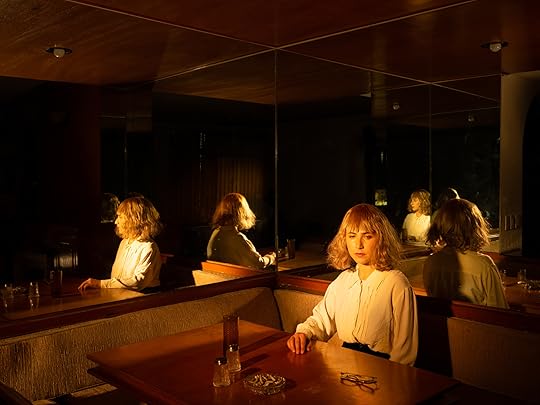 Tania Franco Klein, Mirrored Table, Person (Subject #14), from Subject Studies: Chapter 1, 2022
Tania Franco Klein, Mirrored Table, Person (Subject #14), from Subject Studies: Chapter 1, 2022Courtesy the artist
New Photography 2025: Lines of Belonging – New York
This year marks the fortieth anniversary of the Museum of Modern Art’s New Photography program of annual exhibitions that have, over the decades, brought then-emerging artists, including Philip-Lorca diCorcia, Rineke Dijkstra, and Lieko Shiga, to wider renown. MoMA’s latest edition considers themes of belonging as explored by a baker’s dozen of artists and collectives—hailing from Johannesburg, Kathmandu, New Orleans, and Mexico City—who weave personal stories with broader colonial histories. Gabrielle Goliath and Prasiit Sthapit are among the photographers, along with Sandra Blow—whose whose tender portraits of friends in Mexico City’s queer underground attest to photography’s community-making potential.
New Photography 2025: Lines of Belonging at the Museum of Modern Art, New York, September 14, 2025–January 17, 2026
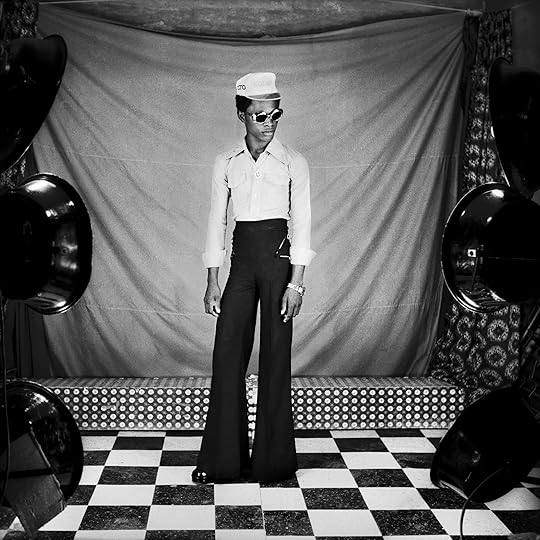 Samuel Fosso, Autoportrait, From the series 70’s Lifestyle, 1975–1978
Samuel Fosso, Autoportrait, From the series 70’s Lifestyle, 1975–1978© the artist and courtesy Yossi Milo, New York
Samuel Fosso – New York
“I wanted to show how good I look,” Samuel Fosso once said of 70s Lifestyle (1975–78), a series he began as a teenager. Autoportrait, Fosso’s first solo exhibition in New York in two decades, certainly succeeds in this goal. The show celebrates the Cameroonian-Nigerian photographer’s self-portraiture, which calls upon and reinvents traditions of studio photography from West Africa and the African diaspora. In addition to 70s Lifestyle, which fuses the visual language of highlife culture with the bold attitude of young Black Americans as seen in magazines of the era, African Spirits (2008) features Fosso adopting the personae of such revolutionaries as Angela Davis, Patrice Lumumba, Martin Luther King Jr., and Nelson Mandela.
Samuel Fosso: Autoportrait at Yossi Milo, New York, through November 8, 2025.
 Man Ray, Rayograph, 1922
Man Ray, Rayograph, 1922Courtesy The J. Paul Getty Museum, Los Angeles © Man Ray 2015 Trust/Artists Rights Society (ARS), NY/ADAGP, Paris 2025
Man Ray – New York
“I have freed myself from the sticky medium of paint and am working directly with light itself,” declared a young American in Paris upon his invention of what he named, after himself, the “rayograph.” In 1921, Man Ray had discovered that, by placing everyday objects—such as scissors, keys, a wishbone, and a mousetrap—on photosensitive paper and exposing it to light, a new kind of photography was possible, one that dispensed with the camera entirely in its spectral, chance mash-ups, which quickly became the toast of Dadaist Paris. When Objects Dream includes some sixty rayographs, illuminating how the artist’s “crimes against chemistry and photography” (as he winkingly described them) informed the rest of his rebellious experimentation, which spans painting, cinema, drawing, and photography.
Man Ray: When Objects Dream at the Metropolitan Museum of Art, New York, September 14 through February 1, 2026.
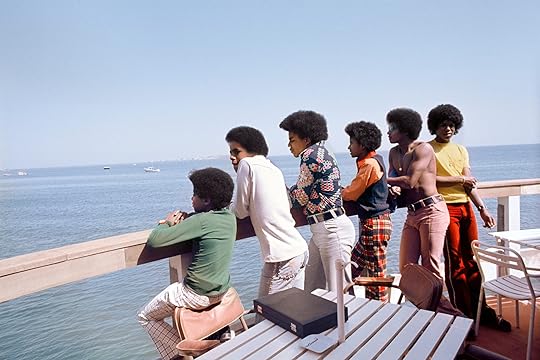 Kwame Brathwaite, Untitled (Jacksons on Boat from Goree Island), 1974
Kwame Brathwaite, Untitled (Jacksons on Boat from Goree Island), 1974© Kwame Brathwaite Estate
Black Photojournalism – Pittsburgh
At its height in the 1930s, the Pittsburgh Courier was read by hundreds of thousands of readers across the United States, one among many Black newspapers to report on the burgeoning civil rights movement and the struggles for equality and social justice. Newspapers such as the Courier, Atlanta Daily World, and The Chicago Defender take center stage in Black Photojournalism, an exhibition at the Carnegie Museum of Art focused on Black photographers who, from the post–World War II era through the 1980s, helped create the first draft of history. One searing image by Ming Smith, made in 1976, the year of the US bicentennial, points up the aspirations of the American Dream and its limitations: A man gazes outward in reflective sunglasses while the stripes of three flags appear like prison bars.
Black Photojournalism at the Carnegie Museum of Art, Pittsburgh, September 13, 2025–January 19, 2026
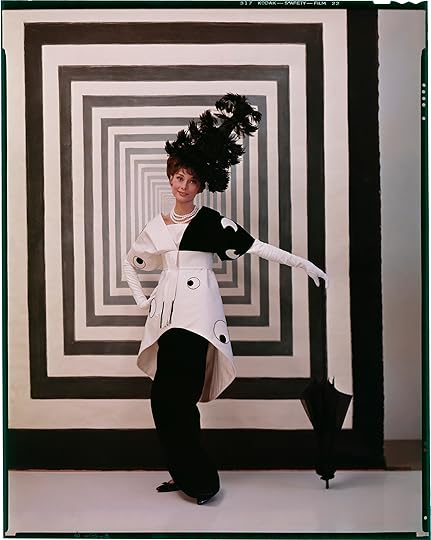 Cecil Beaton, Audrey Hepburn in costume for My Fair Lady, 1963
Cecil Beaton, Audrey Hepburn in costume for My Fair Lady, 1963Courtesy the Cecil Beaton Archive, London
Cecil Beaton – London
Renowned photographer, illustrator, costume designer, diarist, arriviste, and court photographer to the British royal family, Cecil Beaton is synonymous with glamour. Cecil Beaton: Fashionable World explores his groundbreaking society portraits, tracing an illustrious career from the Jazz Age of “Bright Young Things” to the glitterati of My Fair Lady (1956) and Gigi (1958). The show’s trove of photographs, costumes, and ephemera places the viewer into the mind’s eye of the acclaimed “King of Vogue,” whose stylized, highly theatrical portraits of a bygone beau monde once offered starry escapism during the interwar and early postwar era. As Beaton once said, “Be daring, be different, be impractical, be anything that will assert integrity of purpose and imaginative vision against the play-it-safers, the creatures of the commonplace, the slaves of the ordinary.”
Cecil Beaton: Fashionable World at the National Portrait Gallery, London, October 9 through January 11, 2026.
 Ben Shahn, Liberation, 1945
Ben Shahn, Liberation, 1945© 2025 Estate of Ben Shahn/Licensed by VAGA at Artists Rights Society (ARS), NY
Ben Shahn – New York
The painter Ben Shahn spent his career chronicling and confronting the social issues of his era—from censorship and authoritarianism to the labor movement and civil rights. Ben Shahn, On Nonconformity marks the first US retrospective of the artist’s work in nearly half a century, showcasing the enduring relevance of Shahn’s vision. A highlight includes a selection of photographs—both those taken by Shahn himself and by peers, such as those who worked for the Farm Security Administration—that served as his muse. “One of the main goals of this exhibition is to illuminate the under-appreciated complexity of his aesthetic, the multifaceted layered quality of his work, which is largely indebted to photography, both his own photographs and those of others,” notes curator and art historian Laura Katzman. “Photography was central to Shahn’s vision and his working process.”
Ben Shahn, On Nonconformity at The Jewish Museum, New York, through October 26, 2025.
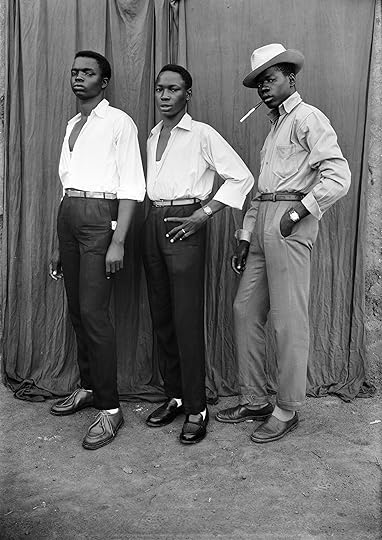 Seydou Keïta, Untitled, ca. 1952–55
Seydou Keïta, Untitled, ca. 1952–55© SKPEAC/the estate of Seydou Keïta and courtesy The Jean Pigozzi African Art Collection
Seydou Keïta – New York
Seydou Keïta captured the dignity and the dreams of the people who posed in his studio in midcentury Bamako, during Mali’s turn to independence. With his ingenious use of props and backdrops, the photographer struck an elegant balance between formality and intimacy, timelessness and urgency. As Kobby Ankomah Graham writes in Aperture’s Summer 2025 cover story, “Keïta’s subjects gaze directly into the camera and claim their place in history on their own terms.” A retrospective at the Brooklyn Museum celebrates Keïta’s own rightful place in history—as an all-time great whose name should be as well-known as that of August Sander, Irving Penn, or Richard Avedon.
Seydou Keïta: A Tactile Lens at Brooklyn Museum, New York, October 10 through March 8, 2026.
 Hans Blaser, Portrait of Germaine Krull, Berlin, 1922
Hans Blaser, Portrait of Germaine Krull, Berlin, 1922 © Germaine Krull Estate, Museum Folkwang, Essen
Germaine Krull – Germany
Germaine Krull, the legendary modernist photographer, had many nicknames. One anarchist friend dubbed her the “Iron Valkyrie” for her interest in industrial forms, as seen in Métal (1928), a slight but epochal photobook whose tightly cropped, strange-making photographs of the Eiffel Tower and other steel structures launched her career in interwar Paris. She called herself chien fou—crazy dog—and this is the title of an exhibition opening at Museum Folkwang, the home of her estate since 1995. The show examines how Krull balanced her experimental vision with her role as a working photojournalist, drawing overdue attention to an oeuvre that spans reportage, writing, portraiture, and avant-garde photomontage across four continents.
Germaine Krull: Chien Fou at Museum Folkwang, Essen, Germany, November 28, 2025–March 15, 2026
September 4, 2025
David Alekhuogie Sees Blackness at the Core of Modern Art
Look at the core of Western modernism. See the Blackness. See African aesthetics. Or, rather, see the ways that Western modernism claimed to know these aesthetics but failed to do so. See through a Black gaze instead.
These are the invitations and redirections that animate David Alekhuogie’s project A Reprise (2019–ongoing). The series is anchored in a body of work by Walker Evans produced on the occasion of African Negro Art, a 1935 exhibition at the Museum of Modern Art, New York, which showcased more than six hundred sculptures from the African continent—most of which had been pillaged to furnish American and European collections. Evans was commissioned to photograph selected sculptures; his images were subsequently published in seventeen portfolios—each with 477 photographs—which were circulated to institutions across the United States and used to teach African art history. Decades later, a selection of the photographs was republished in Perfect Documents (2000), a catalog for an exhibition of Evans’s photographs at the Metropolitan Museum of Art.
It was a Western lens that made Evans’s photographs possible. But in Alekhuogie’s Reprise, the West’s supposed claim to these sculptures—which was reiterated through both literal and photographic capture—is disrupted. Alekhuogie rephotographs Evans’s pictures and builds three-dimensional cutouts, turning photographed sculptures into sculpture-based photo collages. These are set against lively, brightly hued textiles and rephotographed again, sometimes with Alekhuogie’s hand in the frame.
The resulting assemblages, as Alekhuogie notes in this conversation, attest to a chain of transformations and cross-cultural translations between African aesthetics, Euro-American cultural modernism, and postcolonial critique. Here, having been metaphysically disassembled by the art-historical machinations that produce discrete and distantly beheld objects, the sculptures are reassembled by Alekhuogie. It’s as if they have regained the animacy and fullness of presence with which they were imbued prior to their expropriation and display for Western eyes.
 David Alekhuogie, Pull_Up HillFigure, 2019
David Alekhuogie, Pull_Up HillFigure, 2019  David Alekhuogie, Pull_Up w,o,b 2, 2017
David Alekhuogie, Pull_Up w,o,b 2, 2017 Zoë Hopkins: David, before you were showing in galleries, you worked in fashion photography and commercial photography. I’m curious to know how that background informs this body of work, A Reprise. I’m looking at the fabrics in the backdrop and at the way the photographs are staged, and I’m reminded, of course, of the sartorial world and fashion editorials. I’m looking at the way things are staged and this kind of editorial language and wondering if you could give some hints of what aspects of your career rubbed off on this project.
David Alekhuogie: My relationship to photography really starts through music. The fashion photography, the editorial photography, came after working in music journalism. It’s interesting how Black musicians and artists have been able to formulate this language of the radical avant-garde. Even in pop culture, people have been able to thrive through using performance to circumvent things like ownership and cultural capital and being looked at. How do you deal with the task of being looked at or being watched, or having the expectations of your behavior mediated through what you’re supposed to do, not just as an artist but as a worker?
I wanted to make work from the perspective of an outsider, because I think that to grapple with broken, inherited cultural capital is to always be an outsider.
Sometime in grad school, I started thinking about modernism and the relationship to the working class. Things like domestic labor became really interesting to me: the history of quilt-making and cooking and various forms of domestic labor that felt specifically modernist. Whether it’s the history of modernist painting or architecture or design, there’s a tendency to look at the working class as part of a mechanistic structure. So, I became interested in the people in the background or the people in the periphery, post–Industrial Revolution. How people are existing in that space or affecting how we think about what it looks like, at least in America, dealing with whatever comes after Jim Crow, or right before. I wanted to find a language that didn’t seem as labored. One of the things I went through when I got to school is that I started to have a disdain for my language and how it didn’t feel like it was my own.
Hopkins: In terms of an artistic language?
Alekhuogie: Yeah. Not only that, but also how I showed up in the corporate world. How I showed up with my friends and family. How I behave when I get stopped by the police. If I was code-switching, I was doing it subconsciously, which made it worse. Anyway, I think of music, poetry, performance as places where I’ve been able to see Black writers, Black artists find space. There’s a sort of avant-garde language of Black aesthetics in taking pieces of things, like collage. I teach this class about what the remix is. I think those elements, at least, are the early things that are part of my practice.
Hopkins: I love your emphasis on the particular relationship that Blackness shares with fragmentation and remixing. What Fred Moten might call “the break”—or a kind of ruptured subjectivity that begins with slavery and reverberates in Black music—feels so important to the way that a reprise is figured or configured as an assemblage. Could you talk about some of the reading or ideas or research that was informing that project and its early phases? In what context did you actually learn about Walker Evans’s Perfect Documents and the MoMA show African Negro Art? What are the ideas and the more practical forms of knowledge that inform A Reprise?
Alekhuogie: I became a student of documentary photography because I felt that was the work that could be the most meaningful for me and my community. I started taking interest in artists like Walker Evans, Dorothea Lange, Gordon Parks, and figuring out this relationship between being a working artist and a modernist artist. When you work in fields like photography, design, advertising, or illustration, you’re part of the service class—you’re providing a service. You learn to cultivate images through the client. In grad school, there was an anxiety about the point of view, which influences how people position documentary, and the desire to convince people—as if they need convincing—that straight photography is art. This kind of tension between the photographer who’s hired to provide a service and the artist who has a vision is how I became interested in Walker Evans’s work.
When I was eighteen or nineteen, I started working as a model. At the time, I was also working in fashion and music and all these different things. One of my good friends from high school was a dancer, and he was super interested in the entertainment industry. So, I had gotten into that world just by virtue of the friend group that I was around, and I started working with brands. For a while, I wanted to be a pro skater. I have multiple lives.
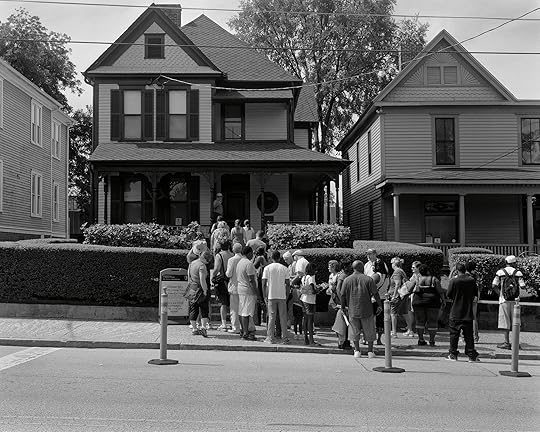 David Alekhuogie, Birth Home, 2013
David Alekhuogie, Birth Home, 2013  Sherrie Levine, After Walker Evans: 4, 1981
Sherrie Levine, After Walker Evans: 4, 1981© The Metropolitan Museum of Art. Courtesy Art Resource, NY
Hopkins: Yes, I can tell!
Alekhuogie: It’s all sort of revolved around this hip-hop lifestyle, which is very much an aesthetic now. But the Walker Evans stuff came really hard in graduate school. It was actually Sherrie Levine’s work that I had seen, where she was using the Walker Evans images as her own images, and this interesting commentary on authorship.
Hopkins: Right, she rephotographs pictures from Evans—and others like Edward Weston and Eliot Porter—straight from their catalogs and then claims authorship over the rephotographed images. And it’s been controversial, of course, because it’s quite easy to say she’s just copying these earlier modernist photographers. It’s the same gesture that Richard Prince is making.
Alekhuogie: Yeah. Just how ridiculous it is, it’s front and center. That’s how I became aware of the work. But at the same time, I had been working as a photographer. I had done people’s graduation pictures and baby pictures and engagement pictures and was doing skate photography. So, I knew what it was like for a person to hit your line and be like, “Could you do this thing?” You know what I mean? That’s what happened to Walker Evans, I’m very much convinced. It turned into this, Oh, now you’re this person who is tasked with doing this job but also with this responsibility for representing modernist photography. So there’s these two things happening at the same time.
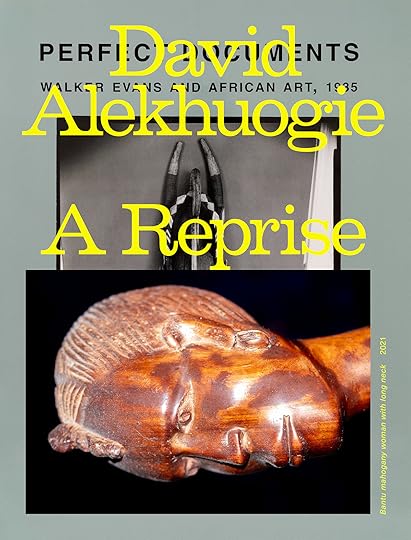 David Alekhuogie: A Reprise 65.00 In A Reprise, David Alekhuogie remixes Walker Evans’s photographs of African art, provoking timely questions about authorship and authenticity.
David Alekhuogie: A Reprise 65.00 In A Reprise, David Alekhuogie remixes Walker Evans’s photographs of African art, provoking timely questions about authorship and authenticity. $65.0011Add to cart
[image error] [image error]
In stock
David Alekhuogie: A ReprisePhotographs by David Alekhuogie. Text by Wills Glasspiegel and Wendy A. Grossman. Interviewer Zoë Hopkins.
$ 65.00 –1+$65.0011Add to cart
View cart DescriptionIn A Reprise, David Alekhuogie remixes Walker Evans’s photographs of African art, provoking timely questions about authorship and authenticity.
A Reprise, David Alekhuogie’s first monograph, confronts the intriguing legacy of narrative and authorship behind Western presentations of African art, and poses timely questions about how Black aesthetics are circulated, accessed, valued, and interpreted today. In 1935, Walker Evans was commissioned by the Museum of Modern Art, New York, to photograph hundreds of African sculptures for the exhibition African Negro Art. Nearly ninety years later, Alekhuogie began investigating Evans’s images, provocatively remixing them into his own vibrant and multilayered photographic collages. Transposing facsimiles of Evans’s original images onto cardboard or paper structures of his own making, Alekhuogie rephotographs these image-sculptures against striking backdrops—often using East and West African textiles—thereby inviting multiple dimensions of viewership. Alekhuogie’s images draw upon the musical idiom of the reprise—a performance of repetition—and stake a claim to crucial, restorative ideas around Black antiquity by questioning our relationship to what we consider fake or original, art or archive.
DetailsFormat: Hardback
Number of pages: 156
Number of images: 110
Publication date: 2025-08-12
Measurements: 8.58 x 11.1 x 1.75 inches
ISBN: 9781597115742
David Alekhuogie (born in Los Angeles, 1986) is a documentary photographer. He received his MFA from Yale University and BFA from the School of the Art Institute of Chicago. His work was included in Companion Pieces, the 2020 iteration of the Museum of Modern Art’s biennial New Photography series, and was presented in Men of Change: Power. Triumph. Truth. at the California African American Museum in Los Angeles. In 2019, he was the recipient of the Rema Hort Mann Foundation’s Emerging Artist Grant. Alekhuogie has had solo exhibitions at Los Angeles Municipal Art Gallery; Commonwealth and Council, Los Angeles; Skibum MacArthur, Los Angeles; and the Chicago Artist Coalition, and has participated in group shows at the Museum of Modern Art, New York; High Museum of Art, Atlanta; Fraenkel Gallery, San Francisco; and Regen Projects, Los Angeles. His work has been published in Aperture, Foam, the New Yorker, the New York Times, Time magazine, Vice, and the Los Angeles Times. He is based in Los Angeles.
Wills Glasspiegel is a filmmaker, artist, and organizer from Chicago. He works with the Era Footwork Crew and codirects the nonprofit Open the Circle. He has directed a range of short films, including Footnotes (2021), Icy Lake (2014), Meet the Era (2016), and Bangin’ on King Drive (2015). He holds a PhD in American studies and African American studies from Yale University.
Wendy A. Grossman is an art and photography historian, writer, educator, and curator based in the Washington, DC, area.
Zoë Hopkins is a writer and critic based in New York. She received her BA in art history and African American studies from Harvard University and her MA in modern and contemporary art at Columbia University. Her writing has been published in Artforum, the Brooklyn Rail, Cultured, and Hyperallergic.
Related Content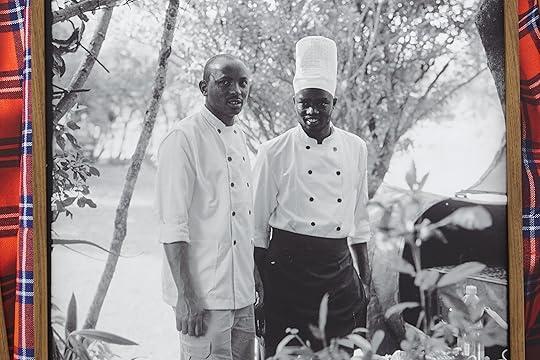 Interviews How David Alekhuogie Navigates the Colonial Past
Interviews How David Alekhuogie Navigates the Colonial Past Hopkins: And also making a living and finding work.
Alekhuogie: Right, yes. That was familiar to me. Also being in graduate school, really struggling with the expectations that I have put on myself as far as my own language and its authenticity. This is another thing that I have a little bit of disdain for, this fixation on Black authenticity from a spectator’s point of view. This is what makes hip-hop special, the realness. You’ve always got to be giving realness. So even if you’re talking in your true voice, you’re writing in your true voice, it comes from a very specific place.
One whole side of my family is pretty heavily gang-related. On the other side, I have gone to primarily private schools almost my entire life. So that causes a really strange dissonance. People don’t understand that the Black experience is not like The Wire. So, that was a serious reckoning in grad school; viewers didn’t have a reference point for the fact that Black interior life is very broad. For example, someone on my critique panel once said that they wouldn’t know I was Black from my images, but those were some of my most diaristic images. There was a need for certain things to point toward authenticity; there was an expectation to perform my Blackness in a way that was convincing. I took this as an opportunity to be a kind of heart-on-your-sleeve, very almost anti-intellectual kind of artist who was, like, “I’m just going to talk about me and my life and my experience.” I was coming to terms with the fact that that did feel like it quenched an appetite people have for looking at a thing that is not their own.
 David Alekhuogie, Rene, 2024
David Alekhuogie, Rene, 2024 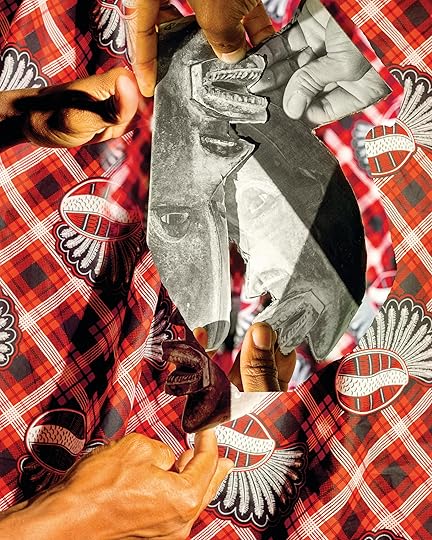 David Alekhuogie, Scramble for Africa pt. 3/3, 2024
David Alekhuogie, Scramble for Africa pt. 3/3, 2024 Hopkins: Which is exactly the appetite Walker Evans was commissioned to feed: he was photographing these African artworks that had been alienated so thoroughly from their natal context so that they could then be redirected toward an American audience, toward a MoMA audience. Some of the published portfolios were distributed to HBCUs in the US, which is so fascinating to me. It’s like the curators of the MoMA show were maybe trying to wipe their hands clean of the colonial context of the exhibition—the pillage and plunder that made it possible—by making a philanthropic gesture toward African Americans. It also suggests their interest in the relationship between African American culture and continental African culture, or in translating one to another. So, in some ways, the Evans photographs are translational documents. And then your sort of reiteration of his photographs is perhaps a metatranslation or a metatext that overlays that original translation.
Alekhuogie: Yes. Definitely. That’s definitely how I think of it. For a while, I have been interested in web-search criteria for what would qualify as African aesthetics or Black aesthetics, and seeing these images pop up, and being motivated by this idea that if this is a kind of cultural capital that people feel they’ve inherited or essentially feel kinship to, then it is going to be seen through this obtuse angle. It’s not going to be direct. I had started noticing: What does my domestic space look like? My dad is Nigerian. My mom is African American by way of Alabama; she eventually moved to Los Angeles in the 1960s, and she was the first in her family to go to college during this “Black Is Beautiful” movement. In her own self-presentation, she’s invested in the beginnings of what Afrocentrism looks like. So, I’m trying to parse how she’s seeking access to her own cultural capital.
That was my primary motivation—the idea of access to “authenticity” through all of these different channels. I exist on this really strange edge, where I feel simultaneously inside and outside. I’m in a perfect world, right? Somebody might hit my email and be, Hey, do you want to do a project with the museum of whatever to photograph these things, and do a whole show? When I was in my second year at Yale, I met Fred Wilson at a dinner. I became interested in his work, in its sort of interrogation of the institution.
 Fred Wilson, Picasso/Whose Rules?, 1991
Fred Wilson, Picasso/Whose Rules?, 1991© the artist. Photograph © Ellen Labenski and courtesy Pace Gallery
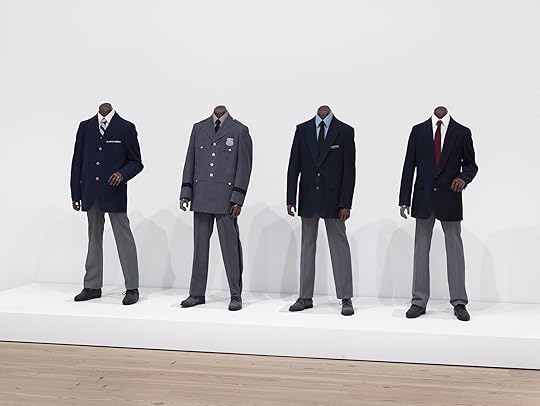 Fred Wilson, Guarded View, 1991
Fred Wilson, Guarded View, 1991© the artist and courtesy Whitney Museum of American Art/SCALA
Hopkins: One of Wilson’s works is called Picasso/Whose Rules? (1991). He made a facsimile of Demoiselles d’Avignon and foisted a West African mask on the painting as if to not only call attention to the origins of Cubism, and the appropriative gestures that made that painting possible, but also to overlay and animate a postcolonial critique on its surface. He’s perhaps best known as an institutional-critique artist, but he’s also thinking about art history, about the place, or no-place, that African objects are afforded in Western institutions and the attendant discourse of Western art history.
Alekhuogie: What I find the most interesting is his work about being a security guard—Guarded View (1991).
Hopkins: Yes, that installation with headless Black mannequins wearing guard uniforms from the Whitney, the Jewish Museum, MoMA, and the Met.
Alekhuogie: That sort of approach is very different from how I see the world. I’m always thinking about the archive—books, texts, records, things that I can come to terms with after the fact. Because I’ve been a DJ since I was maybe sixteen or so. That is kind of my baseline for how I think through everything, really; that’s where all this stuff stems from. I’ve also been interested in how the DJ has changed, what the job is, what the task is. Is it your responsibility to represent whatever the zeitgeist is? Is it your responsibility to make people feel familiar? There’s a special moment as a DJ that happens when people in the room feel they’ve been seen, they’ve been recognized. That is what it means to rock a party—making people feel validated and seen.
For me, it all comes down to this stuff that everybody has access to. I wanted to make work from the perspective of an outsider, because I think that to grapple with broken, inherited cultural capital is to always be an outsider. That’s a part of the premise. I’m at my parents’ house now, and there’s tons of African sculpture. There’s always this negotiation around what’s real and what’s not, what’s vintage, what’s valuable—and that’s why I’m always interested in reproductions.
 David Alekhuogie, Female Figure “A Reprise,” 2020
David Alekhuogie, Female Figure “A Reprise,” 2020  David Alekhuogie, Heddle Pulley 1/1 Speculative View, 2024
David Alekhuogie, Heddle Pulley 1/1 Speculative View, 2024 Hopkins: We also see that whole question of authenticity and value surface in Western discourses on African art that place a premium on the oldest, most traditional, most “authentic” African artworks. But what’s behind that is a colonial understanding of Africa as purely historical, as unable to participate in some telos of progress toward modernity, as a place without historical development at all, in Hegel’s famous assessment. So, when you have these old objects with patina accumulated over the centuries, the West exalts them as “the most” African, and whatever comes after is often seen as sort of secondary by virtue of its newness.
In A Reprise, you rebut this view by recontextualizing Evans’s black-and-white photographs and setting them against those bright fabrics, which are buzzing with vitality and freshness. Of course, we also get flashes of your subjectivity—your aliveness—with the hands that often appear in the frames. Could you talk about the staging? What kind of atmosphere or environment were you trying to conjure up in these images, and what kind of critique does it make?
Alekhuogie: I started to think about the studio as a performative space, the idea that the photographs were about this interrogation of looking at the original subject matter and trying to imagine what it coul be like in real life, but in an abstract way or in an imaginative way. And also, what it would mean if I took something as my own—and what the implications of that would be like. That’s when I became interested in the original fake. And that came from my trip to Nigeria in 2019, and seeing how people dealt with the value attached to branding. The value attached to knowing for sure that a thing was authentic. “Oh, you like this Prada shirt? I got you. Let me just sew that up for you. I made it. It’s real. What do you mean?” There was a kind of vitality. It wasn’t really about the brand so much as it was using that as a subversive force. If I make a Dutch wax-resist print with the Balenciaga logo all over it, then it circumvents or reappropriates the value associated with that brand. But that is a new thing altogether. I started thinking about that as an economic strategy. If I use material that is loaded in this way, then I can traffic with a kind of discursive strategy.
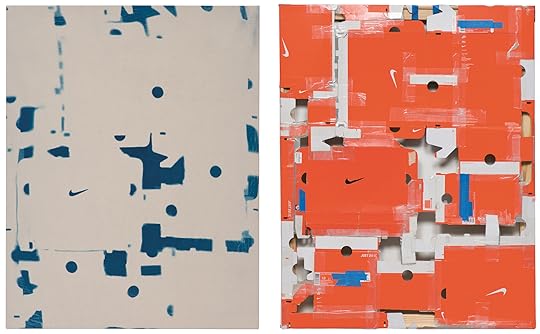 David Alekhuogie, NP16, O, 2015
David Alekhuogie, NP16, O, 2015  Constantin Brâncusi, Vue de l’atelier, 1927
Constantin Brâncusi, Vue de l’atelier, 1927© Brâncusi Estate and courtesy Peder Lund
Hopkins: There are two markers of authenticity that are being indexed and contested in your images. The first is the sculptures themselves, and the second is the Walker Evans images of the sculptures. There’s the original context of the sculptures, and then there’s the context of their entrance into the realm of the “Western art museum” or into the Western idea of art. You make an intriguing intervention of almost inserting the photographed sculptures back into a three-dimensional language: in your images, Evans’s photographs are pasted onto these wooden cutouts that give them the appearance of being three-dimensional. They’re like sculptures again, casting shadows on the backdrop. They also evoke the appearance of an almost Cubist assemblage, which again reminds us of the way Cubism latched onto a notion of African authenticity. Can you talk about that toggling between two- and three-dimensionality and what that does to these questions around authenticity and deracination?
Alekhuogie: When you become interested in being an artist, you start looking at paintings constantly. I became interested in Cubist paintings, but I was more interested in Cubism as a strategy for looking at the world, and then from there, I started thinking about Dadaist art and Futurist art, and what it meant to try to look at a thing from multiple different angles at the same time, and that being this kind of impossible task. For me, that felt specifically like a photographic problem that people were trying to negotiate through painting. As a sculptor who is trying to represent their sculptures photographically, this is a thing that I immediately noticed when looking at Brâncuși’s work, when looking at Picasso’s work, when looking at Braque’s work, anything that you would look at and think it’s been inspired by African sculpture. The questions with those original sculptures, whether they’re from West Africa or wherever, are: How are they dealing with figuration in this way? Where does that idea come from?
 Spread from Virginia-Lee Webb, Perfect Documents (Metropolitan Museum of Art, New York, 2000)
Spread from Virginia-Lee Webb, Perfect Documents (Metropolitan Museum of Art, New York, 2000) 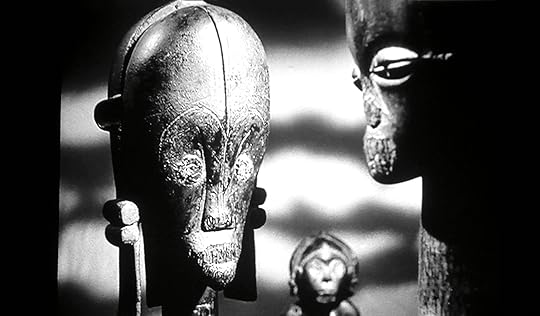 Still from Chris Marker and Alain Resnais, Statues Also Die, 1953
Still from Chris Marker and Alain Resnais, Statues Also Die, 1953© Revue Présence Africaine
Hopkins: In the catalog essay that accompanied African Negro Art, the curator, James Johnson Sweeney, opens with, “Today the art of Negro Africa has its place of respect among the esthetic traditions of the world.” He then elaborates on its “essential plastic seriousness, moving dramatic qualities, eminent craftsmanship and sensibility to material.” We recognize quite readily the terribly patronizing endeavor of a Westerner declaring the aesthetic viability of African art as such. But honestly, I don’t find the Evans photographs in Perfect Documents to be very artful. Perhaps it’s just the constraints that he was working around, but they don’t do much to illuminate the aesthetic power of the sculptures. For example, they’re really tightly cropped, so there’s not much room for the sculptures to breathe in each frame. They feel almost stuck. Though there are a few works that were photographed from multiple angles, for the most part they are either photographed frontally or completely in profile, which makes it difficult to appreciate more angles in the way that you’re talking about.
I’m reminded of a Chris Marker film that came out in 1953 called Statues Also Die, which argues for the art museum as mausoleum, as a place where objects go to die. He focuses on African sculptures that have been pillaged and then brought into these contexts, where there’s nothing suturing them to the people that made them and the communal contexts that gave them life. The way Evans photographs these objects and freezes them in those tight, lifeless frames feels like another instantiation of that death grip. All to say that your project strikes me as one of reanimating the sculptures or reclaiming their livelihood, perhaps from this project of Western institutionalization. And the fabrics have some role to play in that. The hands have some role to play in that.
Alekhuogie: Well, yeah! Absolutely. That’s such an interesting way to put it. Oftentimes I’m trying to figure out the joinery around whether you’re interested in storytelling or whether you’re trying to be as descriptive or articulate as possible about an event and what transpired—your responsibility to what something looks like or feels like, or the texture of it. What motivates the hiring of a person to document these sculptures? It’s so people have an idea of who made them, and why, and what the history is. At that point, you, as the photographer, become part of the process of objectification. But when the question of how you’ve objectified or exploited the sculptures comes up, you want to pull back and be like, I’m a service provider. When it suits you, your authorship is illuminating. When it doesn’t suit you, it’s like, I just work here. One way around that tension is to tell stories that you’re motivated to tell. When the documentary process becomes more subjective, it doesn’t become more truthful, it becomes more honest.
In my first photography class, there was this idea about being a fly on the wall. But that’s not something that I relate to. There’s this discomfort around documentary photography, this fear or anxiety. Or shame. If somebody sees you while you’re looking, you’ve been caught. I had started to notice that a lot of other artists were approaching documentary practices without this “Don’t look at me while I’m doing this thing.”
Advertisement
googletag.cmd.push(function () {
googletag.display('div-gpt-ad-1343857479665-0');
});
Hopkins: It’s completely voyeuristic.
Alekhuogie: Yeah. That was never how I approached it, even when I was doing all this stuff for music publications. I feel in order for me to do that work and make that work, I had to really be at least somewhat exposed in that process. It doesn’t work any other way for me. The lens is mine.
Hopkins: You have to risk something.
Alekhuogie: Yeah. But also, maybe that has to do with legitimacy and why you access these Walker Evans images. Because if I show up to a place and my bio says I went to Yale, what that means is that I’m attached to the history of Walker Evans. This kind of stuff is a part of how people navigate telling stories. I’m always trying to advocate for people to get where they’re trying to go. I’m at the point in my career as an artist or as an educator where I’m trying to figure out how to mentor people through the process. In many ways, I did a bunch of things just to have the privilege of talking how I want to talk, and people not being, Oh, you don’t know what the hell you’re talking about. Which is wild.
Hopkins: Yeah, it is. The lengths that one must pursue to feel at home in oneself. So much of your personhood feels imbricated in this project though. We feel that sense of risk bristling in these photographs, in the way that you’re involving yourself and placing your hands in the frame. An intentional voice emerges.
Could you also talk about where you sourced those fabrics?
Alekhuogie: A lot of them are from my sister. She was a seamstress and designer. They came from trips to Nigeria. Anytime my dad would go to Nigeria, he would bring her fabric. I had started doing textile research in graduate school. Well, not just textiles, but a lot of these craft arts as having all this storytelling potential in the same way that jazz does. My initial point of view was through mostly West African histories. Growing up, my closest friends were Tanzanian and Kenyan, and so a lot of my interest was in those fabrics as well. A lot of my friends who I met when I first started becoming interested in DJing and poetry, we used to go to these poetry nights in Pomona, California. I initially had seen a lot of these fabrics in popular fashion, whether it was Burberry or Prada or Gucci, and I’m figuring out, Oh, that’s northern Kenyan motifs. And then seeing the history of portrait fabrics in Nigeria. Whereas in the States, you might see the shirts from the swap meet where people have their loved ones and stuff on the shirts, and so I became interested in the potential for the craft arts.
 Malick Sidibé, Soirée familiale, 1966–2008
Malick Sidibé, Soirée familiale, 1966–2008© the artist and courtesy the Estate of Malick Sidibé and Jack Shainman Gallery, New York
 Jamel Shabazz, Rude Boy, East Flatbush, Brooklyn, 1982
Jamel Shabazz, Rude Boy, East Flatbush, Brooklyn, 1982© the artist
Hopkins: So the fabric networks the sculptures into these multiple layers of connective tissue that you’re talking about with your sister and your father, and your own research practices, and your friends from Kenya and Tanzania. It brings all of that into the room with the sculptures. I also love that the fabric is given volume and shape; it’s not just this flat backdrop, it’s actually a very animated form. And then the emphasis on staging, for me, also brings to mind a whole canon of African photography from the 1960s and ’70s, like Seydou Keïta and Malick Sidibé, who amplified the staginess of their images rather than masking it, which came, for many of them, from an interest in fashion as well. It feels that your photographs are also invoking a kind of lineage in that sense.
Alekhuogie: Oh, absolutely. I love that. I remember when I first came across some of those pictures. The performance and the richness—I felt this kinship immediately. Jamel Shabazz’s work feels like that too. I was like, That’s how I want to photograph people. People feeling good about how they look, how they’re showing up and being represented, and not feeling as though they’ve been caught.
 David Alekhuogie, Vince Staples for Justsmile, 2022
David Alekhuogie, Vince Staples for Justsmile, 2022All photographs by David Alekhuogie courtesy the artist and Yancey Richardson Gallery
Hopkins: When we last talked, you said something to the effect of, What are the apparatuses by which Walker Evans becomes part of the authorship of Black modernism and Black aesthetics? I want to turn that question back to you because I was stunned by it.
Alekhuogie: Well, for me, it’s hard to run from. It’s central. There’s a performativity of Black aesthetics connected to the idea that you’re always being looked at. There’s a reason why all the funny memes are about Black people—that’s what I love about Black comedy, Black music. It comes from this radical performance. So, it’s hard to avoid Evans’s lens when it comes to African sculpture: it’s a layered, metadialogue about who’s deciding what things look like, what they mean. If you didn’t go to the museum to see the sculptures yourself, you rely on Evans. And his images have influenced what we think about when we think about Black modernism.
One of the things that I’ve been trying to do, for better or worse, in my professional life and my private life, is to figure out all of the things that people love about being Black, the things that people take pride in when it comes to Black aesthetics. A few days ago, I was talking about this concept of swag. Why is it that you might see a working-class Black man, and the hairline is like it was hit by a razor and it was freshly done, and the shoes are spotless. You know what I’m saying? But he might work in a warehouse or something. I feel it’s not controversial to say that Black people probably invest more in this kind of self-beautification. How does that function? You can ask the same question and make it global as well.
One of the things that I noticed in Nigeria was people’s fashioning, how much pride they took in their appearance, and this kind of dandyism. You might see somebody who is very much a corner boy, selling drugs or something, but he literally could be on a runway. On Wednesday, some kids are trying to rob you, but on Sunday they are pristine. I’m trying to figure out these very notable, specific ways that you recognize Blackness.
One of my professors at Yale, the late Robert Farris Thompson, wrote this amazing book Aesthetic of the Cool (2011). He was trying to figure, at least in my perspective, a kind of attempt at a post-racial dialogue around what the aesthetic looks like. What is it about Black people that we recognize as uniquely Black? Does all of this fixation on beauty, or the way beauty is developed or crystallized, come from this feeling of being looked at: I need to be clean; I need to be crisp. To this day, I recognize that it’s much easier for me to look bummy or sort of unhoused or—what’s the term now?—dusty and ashy. It’s much easier for me to make people aware of that than somebody non-Black. When the beard is crisp and the hairline is lined up. I was having this conversation with one of my buddies, about feeling depressed and going to get a haircut and feeling like, You’re back in the game. Don’t count me out. I’m back in there.
Hopkins: Back in the ring.
Alekhuogie: Absolutely.
This interview originally appeared in David Alekhuogie: A Reprise (Aperture, 2025).
August 21, 2025
The Printed Record of Tokyo’s Vanished Underground
In the late 1960s and early 1970s, an artistic revolution swept the world, fundamentally challenging established cultural frameworks. This new energy found fertile ground in Japan, where a postwar momentum for breaking societal norms amplified avant-garde activity. This wave was termed “underground,” adopted into Japanese as angura, a shortened form of the loanword andaguroundo. Though short-lived, spanning roughly from 1966 to the mid-1970s, the underground scene profoundly influenced Japanese cultural expression.
The exhibition Tokyo Underground 1960–1970s: A Turning Point in Postwar Japanese Culture, recently staged at the Mori Art Museum, Tokyo, explored this movement through its ephemera: movie posters, flyers, magazines, books, festival programs, admission tickets, brochures, handwritten correspondence, vinyl records, and archival photographs. Cocurator Kei Osawa, a research fellow at the University Museum, University of Tokyo, drew the materials from his personal collection, amassed over some twenty years. “When I started, postwar ephemera went unnoticed and I became interested in printed materials that weren’t collected by libraries or art museums,” he said.
 Installation view of Tokyo Underground 1960–1970s, Mori Art Museum, Tokyo, 2025. Photograph by Furukawa Yuya
Installation view of Tokyo Underground 1960–1970s, Mori Art Museum, Tokyo, 2025. Photograph by Furukawa Yuya Courtesy Mori Art Museum, Tokyo
The printed matter, organized in glass displays and wall-mounts snaking around a gallery with black walls and high ceilings, was augmented with detailed chronologies covering momentous years of social turmoil: the start of Mao Zedong’s Cultural Revolution; the Beatles’ Japan tour; the arrival of a US nuclear-powered aircraft carrier at Sasebo port amid fierce opposition; protests at the University of Tokyo; the Apollo 11 moon landing; the first women’s liberation demonstration; the restoration of diplomatic relations between Japan and China.
Films catalyzed the Tokyo scene at this time. On June 29, 1966, filmmaker Kenji Kanesaka organized “Underground Cinema,” a screening of experimental work from the United States. The venue was the Sogetsu Art Center, the epicenter of experimental art in Tokyo, where Yoko Ono had first performed her legendary “Cut Piece,” in 1964. From there, countercultural ideas rapidly spread across music, art, manga, theater, butoh dance, and film.
The Mori exhibition revealed Tokyo’s underground to be both interdisciplinary and international. “We don’t feature photography as a discrete field,” Osawa noted. “Photography, like graphic design, was a medium that permeated every area.” At a time when avant-garde art was increasingly non-object based, performative, and politically charged, printed matter served as a tool of transmission.
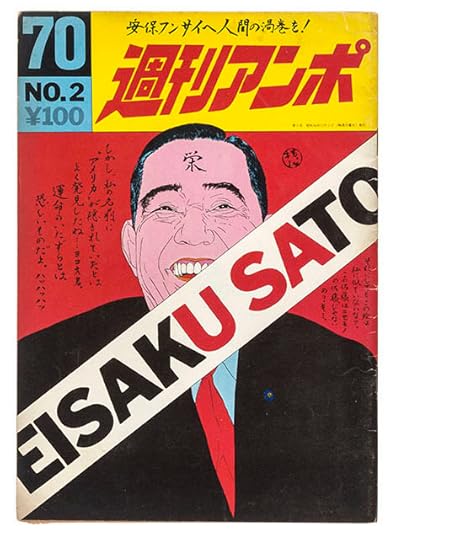 Shūkan Anpo, vol. 2, December 1, 1969. Published by Shūkan Anpo-sha, Tokyo
Shūkan Anpo, vol. 2, December 1, 1969. Published by Shūkan Anpo-sha, TokyoCourtesy Goliga Books
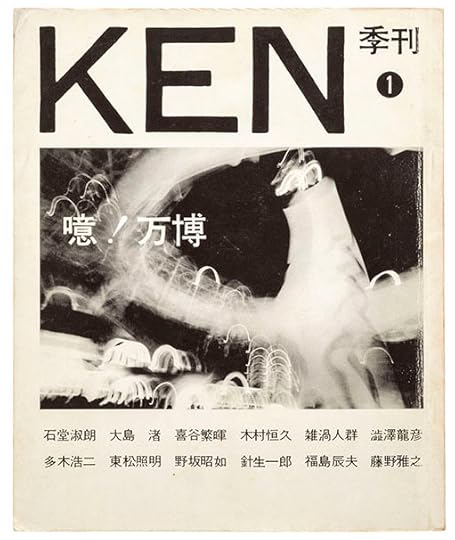 Ken, vol. 1, July 1, 1970. Published by Shaken, Tokyo
Ken, vol. 1, July 1, 1970. Published by Shaken, TokyoCourtesy Goliga Books
The bustling nightlife district of Shinjuku was the primary stage for this cultural ferment. As a major city center within the megapolis—a place where many train lines converge—Shinjuku is a diverse, transitory space. During this period, its plazas, cafes, stores, and event venues held impromptu gatherings and theatrical performances. The independent production company Art Theater Guild, for example, converted the basement of their cinema in Shinjuku into the Scorpio Theatre, and the underground movement coalesced around this screening venue and gathering spot. Its importance was evident in Tokyo Underground, where two dozen framed posters of films and theater plays covered a far wall, floor to ceiling. The posters’ screen-printed designs, several on metallic paper, presented a range of eerily fresh typography and graphic styles.
The exhibition also documented the era’s anti-establishment protests, including opposition to the Vietnam War and the Osaka World Exposition, in 1970. A long, horizontal poster commemorated the “Anti-Expo Black Festival,” in 1969, organized by the performance troupe Zero Dimension. The image shows a tangle of naked bodies evocative of Dante’s Inferno. Activists viewed the Expo as an attempt to smooth over the imminent renewal of ANPO, a controversial security agreement with the United States that allowed for an indefinite American military presence on Japanese soil.
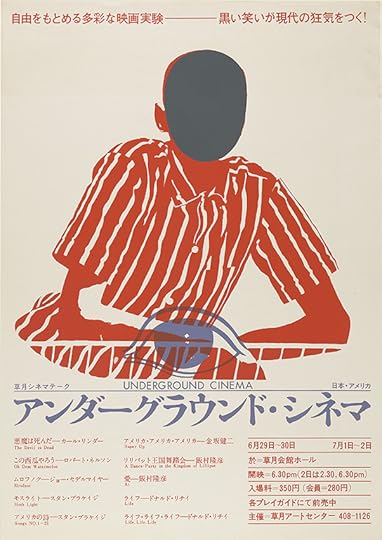 Poster for Sogetsu Cinematheque: Underground Cinema, Japan and USA, 1966. Design by Hosoya Gan
Poster for Sogetsu Cinematheque: Underground Cinema, Japan and USA, 1966. Design by Hosoya Gan Courtesy Keio University Art Center
The West Exit Plaza of Shinjuku Station was a key gathering spot for young people, artists, entertainers, and activists. In an attempt to reclaim public space and quell spontaneous gatherings (often protests), the government officially rezoned the area to prevent people from assembling. In 1968–69, protests in the city, as well as in other parts of the country, were relatively common. Japan’s largest university, Tokyo University, was often a veritable battlefield with students pitted against riot police. By the mid-1970s, however, the protest movement waned and the country entered a new phase of economic development. The underground effectively disappeared. Former participants dispersed—some pursuing spiritual paths, others adapting to new cultural currents or entering the mainstream arts.
The exhibition effectively preserved and revived this history through its material record. “What digital images lack, beyond texture, is a sense of scale,” Osawa said. Indeed, the physicality of the objects in Tokyo Underground reflected the politically charged atmosphere of these years and how those ideas were communicated. Considering the ephemera today, one becomes aware of a shift in how cultural movements form and spread, prompting questions of where—in our current era of surveillance capitalism and platform-modulated expression—are today’s spaces that resist regulation and homogenization?
Tokyo Underground 1960–1970s: A Turning Point in Postwar Japanese Culture was on view at the Mori Art Museum, Tokyo, from February 13 to June 8, 2025.
August 20, 2025
Is a British Exhibition About Resistance Stuck in the Past?
Close your eyes and contemplate the word resistance. Not the kind you had to your childhood homework or the weight of a dumbbell in your hand, but resistance in a political context, born from oppression and the need to fight against persecution. I played this game before a trip to see Resistance, an exhibition that was recently on view at the Turner Contemporary in Margate, England. Though I’m writing from a British context, I’d wager the mental images that come to your mind are similar to mine, all the familiar moments of collective struggle in the West: raised fists, workers with dirty faces, women in late Victorian garb, and throngs of protest crowds.
 Eddie Worth, An anti-fascist demonstrator is taken away under arrest after a mounted baton charge during the Battle of Cable Street, London, October 4, 1936
Eddie Worth, An anti-fascist demonstrator is taken away under arrest after a mounted baton charge during the Battle of Cable Street, London, October 4, 1936© Alamy
For Resistance, Steve McQueen, an artist who is best known internationally for his films Shame (2011) and 12 Years a Slave (2013), brought together photographs spanning one hundred years. Works started from the year 1903, which heralded the Suffrage movement for women’s rights, and ended in 2003 with protests of the war in Iraq. The exhibition and its accompanying book explore the ways that British people have “challenged the status quo.” Respected social-documentary photographers were featured, including David Hurn, a Magnum photographer known for his reportage across the United Kingdom in the 1960s; Janine Wiedel, who documented life in the industrial county of West Midlands during the same period; Vanley Burke, who captured the social awakening of Black Britons in Birmingham; and Tish Murtha, celebrated for her powerful depictions of working class life in North East England during the late 1970s and early 1980s. McQueen also leaned on the knowledge of a research group helmed by Paul Gilroy and Stella Dadzie to bring anonymous works and lesser-known events to the forefront, such as the National League of the Blind’s 1920 march—“a pivotal moment in the fight for disability rights” according to the show’s organizers—and the hunger marches of the 1930s, protests against poverty and high unemployment.
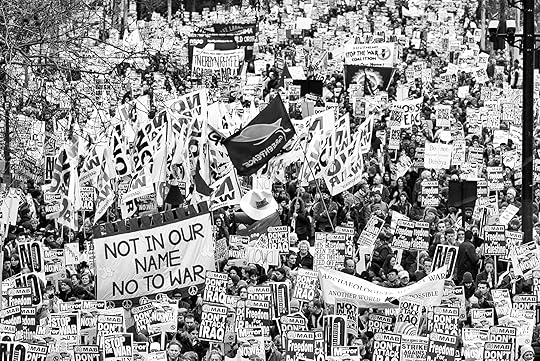 Andrew Wiard, Demonstration against the imminent invasion of Iraq by Stop the War Coalition, the Campaign for Nuclear Disarmament and the Muslim Association of Britain, February 15, 2003
Andrew Wiard, Demonstration against the imminent invasion of Iraq by Stop the War Coalition, the Campaign for Nuclear Disarmament and the Muslim Association of Britain, February 15, 2003Courtesy the artist and reportphotos.com
But why did the exhibition stop in 2003? This is the year the writer Mark Fisher identifies as the end of the future—the point when neoliberal capitalism fully triumphed, ushering in what he calls “capitalist realism” and resulting in cultural stagnation. Smartphone footage of the 2011 London riots, Just Stop Oil demonstrations, internet-powered movements such as #MeToo and Black Lives Matter—all missing from the galleries. In their absence, the exhibition lost the opportunity to connect modes of resistance in the old world and attempts at resistance in the new, when it feels like there are no viable alternatives emerging.
That’s not to say the iconic moments in Resistance don’t need to be seen again and again. These include Syd Shelton documenting pop culture powerfully kicking back against the rise of the far right in Britain at the 1978 Rock Against Racism carnival, and Christine Spengler’s striking portrait of a young girl in Belfast at an IRA funeral procession. As Gilroy reminds us in the accompanying publication, “Unequal access to historical knowledge combines with growing political illiteracy and disengagement. Together, they promote a weakening of imagination that incubates the loss of hope.” Yet, instead of stirring the imagination, Resistance offered mostly familiar tropes of the past.
There seems to be a certain nostalgia for monochrome in political photography, perhaps stretching back to Robert Capa’s famous photographs of the D-Day landings and further entrenched by the iconic images of the struggle for Civil Rights. Of the hundreds of images included in the exhibition, it is astonishing that not a single photograph appeared in color. The fastest film stock for photographers in the revolutionary postwar period was black and white, but the curatorial selection implied that every ensuing struggle after looked the same. This approach to all subsequent political events—which frames the previous century as spilling into this one—risks aestheticizing and antiquating political struggle. Even the show’s typeface called to mind postwar propaganda posters and 1960s espionage movies. If a documentary is made of Resistance, I could predict the soundtrack: The Specials, followed by the Clash, and maybe some Bob Marley, accompanied by Ken Burns–style zooms into the photographs.
 Installation view of Resistance: How protest shaped Britain and photography shaped protest, Turner Contemporary, England, 2025
Installation view of Resistance: How protest shaped Britain and photography shaped protest, Turner Contemporary, England, 2025© Above Ground Studio
For an exhibition that claimed to be timely—and indeed, resistance is as urgent as ever in this era of neoliberal algorithms, resurgent fascism, and growing inequality—there was an odd lack of urgency in its presentation. I’d worried that a show about the fight for justice would seem out of place in a gallery setting, and in the end the show seemed all too comfortable in its surroundings. I saw little correlation between people’s lives today and the historic modes of resistance being represented. There was no attempt to reconcile the familiar aesthetics of protests of the past with the contemporary moment: it was London-centric and “back then,” with not much speaking to what Linton Kwesi Johnson once called “the Lumpen elements”—everyday people who are uninterested in revolutionary politics.
The lack of an imaginative bridge between old and new forms of resistance left the exhibition feeling incomplete. What it needed was curatorial connective tissue to address our current moment, in which dissent feels increasingly ill-equipped to tackle powerful lobbyists with endless money and coercive tech at their disposal. It is striking, too, that there weren’t any curatorial interventions that might have activated these historical moments—the images were hung in the classic white-cube-gallery format, one after the other, horizontally, in simple black frames. How might young women dealing with online misogyny spearheaded by the likes of Andrew Tate draw strength from this show? Or the tired-looking men standing outside McDonald’s with large, boxy Just Eat and Deliveroo backpacks, waiting for their smartphones to tell them what the next order is? Or the working class men and women of Margate I saw populating the area around the Turner Contemporary? Resistance clings to older, more familiar methods of resistance set against older, more familiar forms oppression.
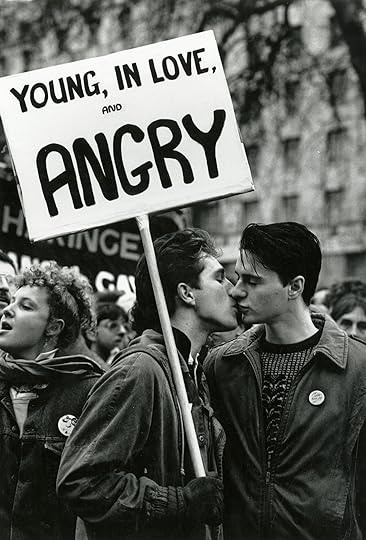 Pam Isherwood, Stop Clause 28 march, Whitehall, London, January 9, 1988
Pam Isherwood, Stop Clause 28 march, Whitehall, London, January 9, 1988© Bishopsgate Institute
 Keith Pattison, Police operation to get the first returning miner into the pit. Joanne, Gillian and Kate Handy with Brenda Robinson, Easington Colliery, Durham, August 24, 1984
Keith Pattison, Police operation to get the first returning miner into the pit. Joanne, Gillian and Kate Handy with Brenda Robinson, Easington Colliery, Durham, August 24, 1984© Keith Pattison
Such pictorial disjunction between past depictions and current problems in a neoliberal age is something the French writer and publisher François Maspero noticed in the late ’80s, as he traveled the Parisian banlieue with the photographer Anaïk Frantz to produce their masterpiece Les Passagers du Roissy-Express (1990). In the book, Maspero writes: “The squalor is disappearing and unemployment is rising. Each generation has its own forms of poverty which maybe only the next generation will know how to comprehend . . . poverty for outside exhibition from the golden age of the picturesque (thank you Robert Doisneau) . . . is now only the fate of dropouts, tramps and drifters . . . but how do you photograph all the poverty behind the smooth walls, the silent walls of depression and fear, of all the strains of everyday life, of so much loneliness?” The same could be said of modes of resistance. We live in a moment of unprecedented flux, with such existential crises as artificial intelligence, climate change, and a new, even darker form of capitalism the French economist Arnaud Orain has called “the capitalism of finitude.” Photographs of outraged crowds are no longer enough.
 Henry Grant, Anti-nuclear protesters marching to Aldermaston, Berkshire, May 1958
Henry Grant, Anti-nuclear protesters marching to Aldermaston, Berkshire, May 1958© Henry Grant Collection/London Museum
Even viewed in its own political context, Resistance is a limiting prism. Much was omitted. Early-2000s grime music, which took the crumbs of socioeconomic ruin and created a twenty-first-century version of punk, was vernacular testimony against the gross inequalities of East London. What about early-web hacker culture that fought against the corporatization of the internet, or the tireless work of Doreen Lawrence—mother of Stephen Lawrence, a young Black British man murdered by white youths in a racist attack in 1993—which culminated in a stronger awareness of institutional racism and amplified questions about policing nationwide? Photographs of these moments exist, and they are within the show’s curatorial parameters; they would have offered something other than black-and-white photographs of protest.
A show about resistance could have leapt off the wall, played with high and low culture, and challenged received notions of good taste. As Elaine Brown, the one-time chairwoman of the Black Panther Party, once quipped about the men in the organization, “We didn’t get these brothers from revolutionary heaven.” What was missing in Resistance was naughtiness: the playfulness, subaltern creativity, and energies that refused to bow to the status quo and middle-class etiquette. This was all flattened in the Turner show, and as I wandered through it, I thought of two exhibitions at London’s Somerset House that trod similar terrain—The Horror Show! (2022–23) and Get Up, Stand Up Now (2019), curated by Zak Ové.
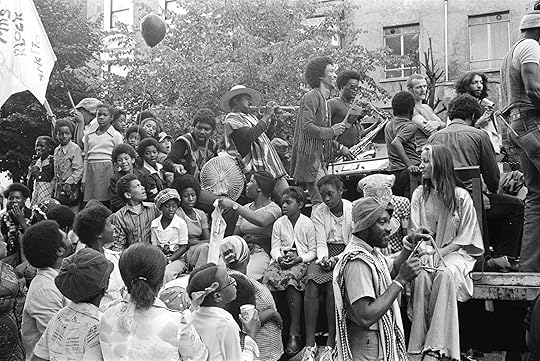 Chris Miles, Notting Hill Carnival, London, 1974
Chris Miles, Notting Hill Carnival, London, 1974Courtesy the artist
Both exhibitions contained ingredients similar to those in Resistance but mashed them up into something new and exciting. The Horror Show! used the figures of the monster, the ghost, and the witch—respectively assigned to the social unrest of the ’70s and ’80s, the haunted ’90s and ’00s (which gave birth to the internet era), and the 2010s (the post-financial crisis years of austerity)—to tell an alternative history of the past five decades in Britain. You came out shocked, disoriented, and charged up. Get Up, Stand Up Now showed resistance in full color, with Afrofuturist sculptures and exuberant footage of the Notting Hill Carnival. Ové described the exhibition as a “place beyond boundaries where we can dare to dream without being limited.” The show was a training ground: It armed its viewers with counterintuitive tricks and cultural technologies that might be applied now. Resistance, by comparison, felt like an echo, an exhibition stuck in the past, looking back at a struggle that has already been lost. Instead of leaving the exhibition buoyed by the energy of resistance, I left with the weight of what felt more like an elegy for it.
Resistance was on view at Turner Contemporary February 22, 2025, to June 1, 2025.
August 19, 2025
“Superfine” Unpacks Self-Expression, Resistance, and Status Through Black Style
Toward the end of Ralph Ellison’s Invisible Man (1952), the unnamed narrator wanders into the New York City subway and witnesses three hipsters strutting through the station in zoot suits:
. . . What about those three boys, coming now along the platform, tall and slender, walking stiffly with swinging shoulders in their well-pressed, too-hot-for-summer suits, their collars high and tight about their necks, their identical hats of black cheap felt set upon the crowns of their heads with a severe formality above their hard conked hair? It was as though I’d never seen their like before: Walking slowly, their shoulders swaying, their legs swinging from their hips in trousers that ballooned upward from cuffs fitting snug about their ankles; their coats long and hip-tight with shoulders far too broad to be those of natural Western men. These fellows whose bodies seemed—what had one of my teachers said of me—“You’re like one of these African sculptures, distorted in the interest of a design.” Well, what design and whose?
The passage serves as the epigraph to Monica L. Miller’s book Slaves to Fashion: Black Dandyism and the Styling of Black Diasporic Identity (2009), the lodestar for the exhibition Superfine: Tailoring Black Style, at the Costume Institute of the Metropolitan Museum of Art, New York. From the narrator’s observation comes an astute definition of flyness. A dandy is not simply someone who knows how to dress finely on special occasions; a dandy is a person who is in service to dressing well every single day, rain or shine. What is Black dandyism? A Black dandy is agitprop: an activist who subverts racial stereotypes by making their artistic or creative intelligence legible through sartorial choices. This is not easy to do. While getting dressed is quotidian, creating a narrative with clothes is a work of profound imagination. Tyler Mitchell’s photo-essay in the Superfine catalog reveals this distinction. In his portraits, details such as a slanted hat brim, a signet ring, or button placement define the wearer’s point of view and amplify their attitude.
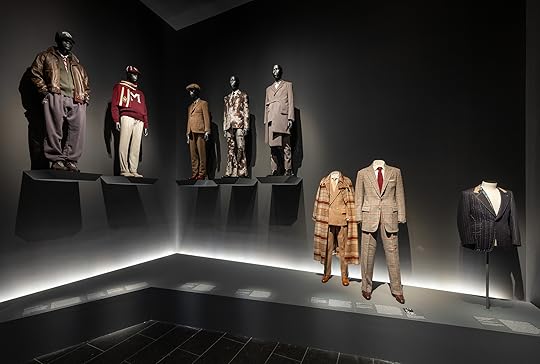 Installation view of Superfine: Tailoring Black Style, Metropolitan Museum of Art, New York, 2025
Installation view of Superfine: Tailoring Black Style, Metropolitan Museum of Art, New York, 2025© The Metropolitan Museum of Art
I recently met with scholars and Superfine catalog contributors Elizabeth Way, Kimberly Jenkins, and Ekow Eshun to explore what it means to be a Black dandy, how the archetype functions in Black culture, and the dandy’s place in history. We discussed iconic figures such as James Baldwin, Fredrick Douglass, Dr. Martin Luther King Jr., and André Leon Talley, and how their sartorial choices relate to their work and legacies. We spoke in depth about the importance of photography as a means to document the trajectory of Black dandyism globally, and about Ellison’s lifelong engagement with the medium.
 James Baldwin standing in front of a mural, ca. 1963–1987
James Baldwin standing in front of a mural, ca. 1963–1987Collection of the Smithsonian National Museum of African American History and Culture, Gift of The Baldwin Family
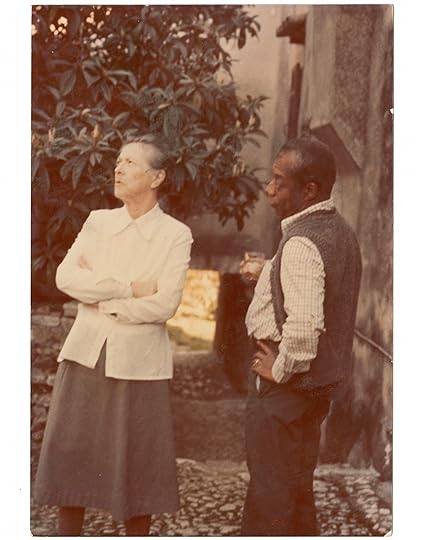 James Baldwin standing with the owner of his French home, December 1978
James Baldwin standing with the owner of his French home, December 1978Collection of the Smithsonian National Museum of African American History and Culture, Gift of The Baldwin Family
Monique Long: I often think about Walter Benjamin’s idea of the flaneur : a detached figure who is an observer in an urban setting at the height of the industrial age. Ekow, this idea closely aligns with your essay in the Superfine catalog and the description of James Baldwin as this solitary alienated figure. What are your thoughts of Baldwin as a dandy?
Ekow Eshun: I was interested in the James Baldwin who left America largely behind. There’s Baldwin in Switzerland, writing the essay “Stranger in the Village,” where he’s alone and feels distinctly alienated and made “other” by the experience of being the only Black person in this Swiss village in the 1950s.
But then there is Baldwin in Paris during the 1970s. He’s coming into himself in an entirely different way. He’s walking along the Left Bank. His appearance is lush and sophisticated; adorned with a scarf over his neck paired with a black top hat, and fur coat, Baldwin looks entirely at home. At the same time, he’s still writing about the experience of being Black in white environments and how difficult that continues to be. Nevertheless, when you look at him physically, something has changed. He’s more aware. He’s taken authorship of his body as well as his words.
I was interested in him as a wanderer, as a traveler, as a discoverer of self—and that journey. In a way, this is maybe the distinction between that and Benjamin’s flaneur. The flaneur walks and walks and walks. Baldwin discovers and finds himself, and I think you see that in how he conjures himself before a camera.
Long: Fascinating that you say the wanderer became a discoverer, but it’s also this notion of gumption, of taking hold of something.
Eshun: This is the distinction between the Black dandy and the Baudelairean dandy. There is more at stake. Baldwin mentions how standing out can be a matter of life and death.
Elizabeth Way: When Baldwin reaches this period in Paris, we also see a massive cultural shift in how men are dressing, the way men are presenting, the way fashion is being produced and perceived in the Left Bank.
 Suit, Morty Sills (American, active mid-to-late 19th century), 1986. Photograph by Tyler Mitchell
Suit, Morty Sills (American, active mid-to-late 19th century), 1986. Photograph by Tyler MitchellCourtesy The Metropolitan Museum of Art, New York, Alfred Z. Solomon–Janet A. Sloane Endowment Fund, 2023
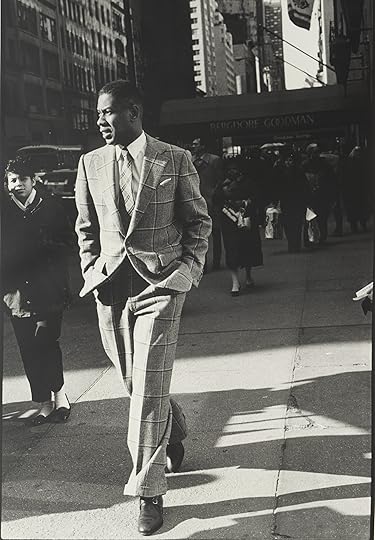 Arthur Elgort, André Leon Talley 5th Avenue, 1986
Arthur Elgort, André Leon Talley 5th Avenue, 1986Courtesy The Metropolitan Museum of Art, New York, The Irene Lewisohn Costume Reference Library
Long: Barkley L. Hendricks captures that so beautifully in his paintings of that period. You can see the documentation of this radical shift in sartorial style in his photography, which eventually became the foundation of his painting.
Kimberly Jenkins: My mind instead wanders to André Leon Talley. During this same time, Talley was traveling to Europe. In 1974, he began his apprenticeship at the Costume Institute under the helm of Diana Vreeland. I can’t help but think about what he was exploring at that time and how free he felt, enjoying, in some ways, being the only Black, queer, and plus-size male figure in these spaces—though there was some tension.
Eshun: The tension you’re talking about is the freedom and constraint between being within the crowd and standing out from the crowd. André Leon Talley is an interesting example because I’m not sure if he ever experienced that freedom, as he was more interested in staying within the structure rather than going beyond it.
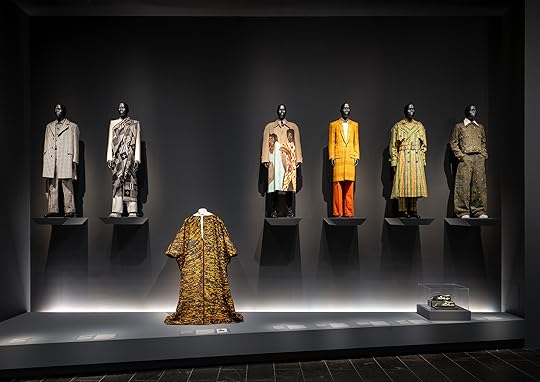 Installation view of Superfine: Tailoring Black Style, Metropolitan Museum of Art, New York, 2025
Installation view of Superfine: Tailoring Black Style, Metropolitan Museum of Art, New York, 2025© The Metropolitan Museum of Art
Long: I would love to build upon that idea of freedom for the Black dandy through the notion of constructing and deconstructing masculine and feminine characteristics. Shantrelle P. Lewis writes in Dandy Lion: The Black Dandy and Street Style (Aperture, 2017) that a dandy is a queer figure. Not so much as a declaration of sexuality, but one that challenges assumptions regarding gender, affectation, flamboyance, and even high camp aesthetics.
Kimberly and Elizabeth, you both discussed this idea at length in your essays for the Superfine catalog. There’s this idea of Ellen and William Craft cross-dressing to achieve liberation. Could you talk about that? Even the duality of the phrase “ Dandy Lion” that Shantrelle coins. This idea of fierceness, but also a reference to one of the most delicate flowers.
Way: In the case of Ellen and William Craft, William writes about their escape in the 1860 narrative Running a Thousand Miles for Freedom We get a sense of how they built this dandy character together—a character that consists of Ellen’s body but also William’s presence.
Ellen Craft is a woman who wants to pass as a white male slaveholder in order to escape slavery with her husband, but they must overcome all these contingencies—for example, she can’t write, so they tie up her arm in a sling. There was a fundamental idea in the nineteenth century of what it meant to be an invalid, what it meant to be ill. What it meant to be elite and ill, to be taken care of. And that state was considered feminine even for men. Ellen plays with these ideas of queerness and gender and how it introduces itself into the concept of masculinity for men at this time, later addressed within an American context known as the “elite man.”
Superfine elevates Blackness in the public consciousness, allowing people to understand its importance, impact, and beauty, recognizing it as art.
Jenkins: In my essay, I examine Sylvester James Jr., an American singer-songwriter, primarily active in the genres of disco, rhythm and blues, and soul. Sylvester was known for his flamboyant and androgynous appearance, but wasn’t interested in the use of labels for gender fluidity. In terms of his fashion, it was about standing out, borrowing different looks from vintage or thrift stores, and playing with gender in various ways.
For example, I mentioned a jacket by Pat Campano, a sequined jacket similar to those of the early 1980s commonly seen on Phyllis Hyman or even later on Luther Vandross. It’s a fusion of the masculine and feminine elements that create this tension, while simultaneously fostering a sense of freedom through style, fashion, and dress.
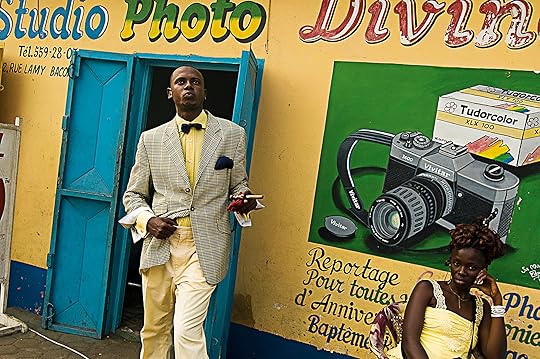 Daniele Tamagni, Lalhande in Front of a Photo Studio, from the series Gentlemen of Bacongo, Brazzaville, Congo, 2007, from Dandy Lion (Aperture, 2017)
Daniele Tamagni, Lalhande in Front of a Photo Studio, from the series Gentlemen of Bacongo, Brazzaville, Congo, 2007, from Dandy Lion (Aperture, 2017)Courtesy the artist
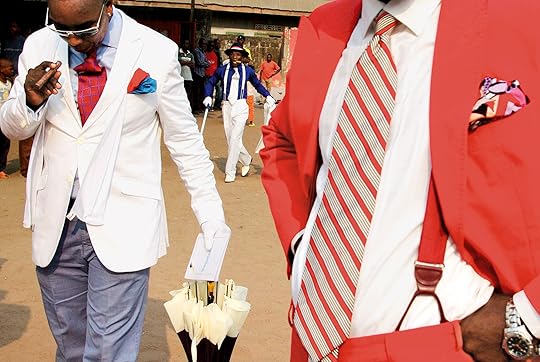 Baudouin Mouanda, from the series Sapeurs de Bacongo, Brazzaville, Congo, 2008, from Dandy Lion (Aperture, 2017)
Baudouin Mouanda, from the series Sapeurs de Bacongo, Brazzaville, Congo, 2008, from Dandy Lion (Aperture, 2017)Courtesy the artist
Long: Elizabeth, you recently organized an exhibition, Africa’s Fashion Diaspora, at the Museum at FIT, featuring several generations of fashion designers of African descent from the 1950s to the present. Are there aesthetic characteristics or distinctions that define a dandy based on where they’re from?
Way: What I found so exciting about Africa’s Fashion Diaspora and these designers is that they leaned into their cultural identity in terms of fashioning themselves. You can see the cultural background, the ethos, and the geography of these dandies in a room. But what they all have in common is discipline—this idea of freshness, crispness, and cleanliness.
Jenkins: Color and materiality definitely come into play from a geographical perspective. When you look at the Sapeurs in Congo, or various parts of Africa, there’s this attraction to bright colors. Often, these dandies are incredibly conspicuous with logos and designer labels. Not only are vibrant colors more appreciated, but there’s more to communicate in terms of portraying what you can afford, which can show your sense of self-worth or assist with social mobility.
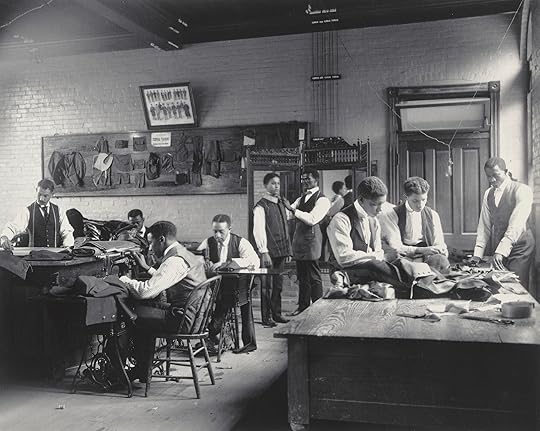 Frances Benjamin Johnston, Tailor boys at work, 1899–1900
Frances Benjamin Johnston, Tailor boys at work, 1899–1900Courtesy The Museum of Modern Art, New York
Eshun: We can see distinctions between the visual aesthetics of dandyism in various places, but what I’m more interested in stressing, as you say, Kimberly, is the inherently hybrid syncretic, cosmopolitan nature of the dandy. The dandy takes from everywhere to make their own. The idea of the dandy is also a project against authenticity. Against the idea that there is a singular way to dress rather than a form of self-fashioning that is constantly in process, in a way, both in tune with and against the currents of the everyday.
Way: That’s an important concept to think about when women use suiting, use menswear to craft their sartorial personas, because it’s not about passing as men; it’s about destabilizing the idea of masculinity and femininity.
Eshun: In the 1990s, I interviewed Prince at Paisley Park in London. It was fascinating. Similar to the earlier mention of Sylvester, Prince played with these notions of appropriateness and the ways a Black person might comport themselves. Prince’s presence went beyond the stage. His high heels and costumes invoke a sense of freedom, a way of walking through the world unapologetically. In a way, the dandy offers space for others who may be less free to occupy, explore, and assert space on their own terms.
 Installation views of Made You Look: Dandyism and Black Masculinity, The Photographers’ Gallery, London, 2016. Photographs by Kate Elliott
Installation views of Made You Look: Dandyism and Black Masculinity, The Photographers’ Gallery, London, 2016. Photographs by Kate Elliott 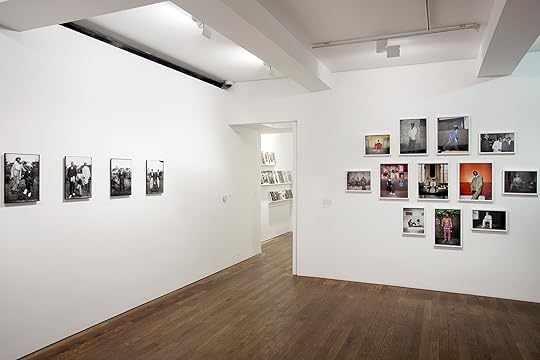
Long: Superfine is a multimedia exhibition, but photography is something we always return to when thinking about the Black dandy. The ethos of this presentation of someone who’s negotiating racial stereotypes and wearing this kind of armor, this style that’s beyond reproach.
Can we discuss this relationship between photography and the Black dandy? Ekow, you had your show Made You Look: Dandyism and Black Masculinity, at the Photographer’s Gallery, in London, several years ago. Do you want to talk about the impetus for the show and why you decided to focus on photography?
Eshun: The camera has been responsible for typologizing and stereotyping Black figures. The dandy alters this narrative by staging a strategic intervention in front of the camera, using the lens to reassert visibility and presence on their own terms. I continue to be interested in the simultaneous way that photographers behind the lens and dandies in front of the lens collaborate as a means to disrupt an overarching white gaze, to suggest other ways of comportment. This is partially about dress, but it’s also about status and how you command presence.
Jenkins: That’s beautifully said. I completely agree. That need to mediate the image that you’re presenting based on the past. It is a great deal of pressure and part of the injustice of our inability to just be ourselves.
I think of the nineteenth-century figure of a Zip Coon: the gaudy-dressing dandy who doesn’t know his place, as seen in Edward Williams Clay’s Life in Philadelphia, depicting mocking cartoons of a fashionable Black man who’s always getting it wrong—he’s so gaudy, he’s so colorful, he doesn’t understand the codes of tasteful dress. Finding that place between defying those stereotypes and being authentic while pushing boundaries is quite a balancing act.
Related Items

Dandy Lion: The Black Dandy and Street Style
Shop Now[image error]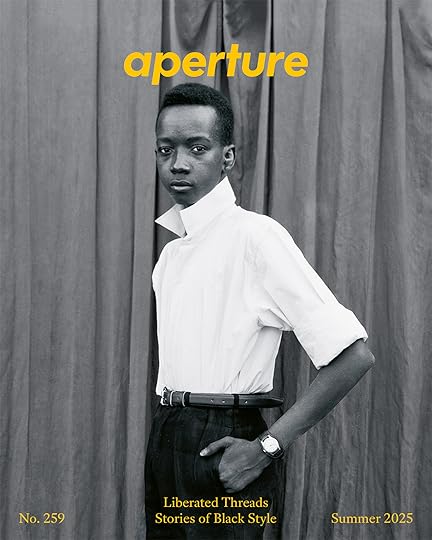
Aperture No. 259
Shop Now[image error]
The New Black Vanguard: Photography Between Art and Fashion
Shop Now[image error]Way: Photography, as opposed to other forms of capturing images, is an interesting place for Black dandyism to exist. There is agency in the photographer, but Tina Campt also talks about this agency in the sitter. Campt looks specifically at prison photos, explaining that there is still a way to listen to that image and to see that subject pushing back. The camera is not neutral. There is power up for grabs, but the sitter can snatch a little bit of that even when the odds are stacked against them.
However, I also think a great deal about the concept of the counter-archive and its importance for Black people to create images for a sympathetic audience. Photography on the Color Line (Duke University Press, 2004), by Shawn Michelle Smith, examines the counter-archive. It’s not just about minstrel shows and cartoons that specifically think about fashion. It’s postcards of Black bodies being lynched. It’s the Southern views of this romantic idea of Black poverty, not to mention the scientific racism that the camera has been applied to.
It’s this avalanche of images every time a Black person sits in front of the camera to express themselves. Frederick Douglass and W. E. B. Du Bois were producing images for vast and largely white audiences, but there were also many amazing family albums, images that were made to sit on mantles, which beautifully define the counter-archive.
 Dick DeMarsico, Dr. Martin Luther King, Jr., half-length portrait, facing front / World Telegram & Sun , 1964
Dick DeMarsico, Dr. Martin Luther King, Jr., half-length portrait, facing front / World Telegram & Sun , 1964Courtesy the Library of Congress
 Cover of Aperture, issue 223, “Vision & Justice,” Summer 2016
Cover of Aperture, issue 223, “Vision & Justice,” Summer 2016 Long: I like to think that Dr. Martin Luther King Jr. was aware of Frederick Douglass’s strategy as well. I know King doesn’t often get included in the discussion around dandies, but I would argue he was one. Kimberly, I spotted your issue of Vision and Justice [Aperture No. 223, 2016] behind you, which is what prompted my thought of Dr. King in his signature uniform of the traditional suit. Yet, the media was steadfast in projecting a particular image of Dr. King. Even when they marched in the hot sun, you can almost read on his face that he wants to hold on to that agency, the agency of the sitter powerfully linking arms with men who are dressed exactly like him.
In a way, you see the ethos of street photography. An idea of this intersection between fashion and what people wear on the street as body armor and self-expression. Dr. King also had to contend with the emerging medium of television.
Jenkins: Also, the images of him being arrested sabotaged all the respectability that they were trying to convey.
Way: It was the footage of people so carefully dressed and being treated so violently, so appallingly. It was those images being broadcasted across national and international television that were so powerful.
Eshun: Perhaps we should address the idea of “dandy” as a verb. To dandy. To dandy, which might mean to assert, to make visible, to disrupt, to disquiet, to defy taste, to reach beyond all these things. The consequences and implications of dress as a form of politics, as a form of display, as a form of standing out in consciousness of the risk that that might evolve.
 Tyler Mitchell, Harlem Stoop, 2024
Tyler Mitchell, Harlem Stoop, 2024© the artist and courtesy Gagosian
Long: The importance of Black image making is such a powerful sentiment, one that is clearly stated throughout the show and exhibition catalog, particularly through Tyler Mitchell’s body of work as a young photographer. We’re able to gain an understanding of how his lens adds nuance to the Black male gaze, image making, and the self-fashioning of Black bodies today. He’s at this intersection of editorial—which constructs fantasy, creates desire, longing—and visual art.
Eshun: Tyler’s fantastically gifted at bringing into reality what might otherwise remain in dreaming. He understands the nature of what it takes to craft an image, to present a sense of longing, desire, memory, and hope for purity. He also educates himself on the work of other photographers, such as Gordon Parks. I think he’s found a compelling visual language that has elegance and sophistication, yet at its heart, a desire for a world where the Black figure is recognized in its fullness and splendor.
Way: He was a critical artist in the catalog in relation to the exhibition. The American public views the Costume Institute exhibition largely through the lens of the gala, as well as the reputation of the Metropolitan Museum of Art as an elite space. Tyler not only captures the beauty of Black men, but he also helps the viewer understand why this subject matter belongs in the Costume Institute and at the Met. This is only the second menswear exhibition the Costume Institute has ever done in its history.
Superfine: Tailoring Black Style elevates Blackness in the public consciousness, allowing people to understand its importance, impact, and beauty, recognizing it as art. These images help take us there, not only for Blackness but also for male fashion history, which is often not deemed as interesting, beautiful, or worthy of exhibition.
Superfine: Tailoring Black Style is on view at the Metropolitan Museum of Art, New York, through October 26.
August 15, 2025
Seydou Keïta’s Revelatory Portraits of Malian Life
A young woman gazes confidently at the camera, her black hair adorned with white cowrie shells; a man poses in a sharply tailored suit and glasses, embodying an elegance that is at once African and European. The act of sitting for a portrait in Seydou Keïta’s studio was a quiet but deliberate assertion of identity in a heady age of self-determination.
Taken mostly between the late 1940s and 1960s, Keïta’s portraits are master classes in texture and composition. His studio—located on land his father gave him behind a prison in the Malian capital city of Bamako—welcomed a diverse range of visitors after its 1948 opening, from government officials, traders, and intellectuals to artists and everyday members of Mali’s rising middle class. Some went to the studio for professional pictures; others went to record their growing status and personal achievements in ways that could be hung on the walls of their homes, stored in family albums, or given away as gifts. Much like the highlife music that would soon become the rage across West Africa—a genre blending traditional African elements with Western influences, creating the aspirational soundtrack to African independence—Keïta captured not just the aesthetics of an era but the ambitions of a people. His process was meticulous. Known for his patient, precise use of a large-format camera, he favored natural over artificial light. His signature use of shallow depth of field ensured that attention remained on his subjects and their attire, creating an intimacy that distinguished his work from more conventional studio photography of the time.
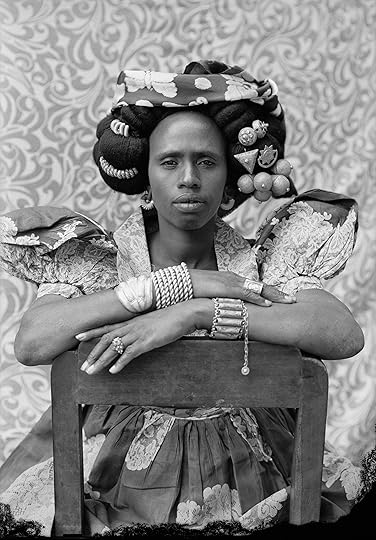 Seydou Keïta, Untitled, ca. 1953–57
Seydou Keïta, Untitled, ca. 1953–57 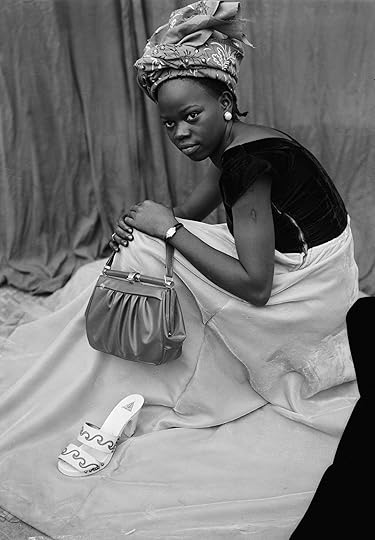 Seydou Keïta, Untitled, ca. 1952–55
Seydou Keïta, Untitled, ca. 1952–55 Moreover, as the late Nigerian curator Okwui Enwezor—one of Keïta’s foremost champions and exegetes—has noted, the photographer conceived of his studio as a porous site, forgoing the late-Victorian device of painted, idealized backdrops for quotidian, ever-changing textiles that allowed him the flexibility to make work in various settings. “Any space could become a studio for Keïta,” Enwezor wrote in 2010.
Born in Bamako in 1921, Keïta began his journey with photography in 1935 at the age of fourteen when his uncle gave him a Kodak camera. He would eventually work with Mountaga Dembélé, a former schoolteacher who shifted careers to become one of Mali’s first professional photographers. At one point, Dembélé entrusted all his photographs to Keïta, prompting some scholars to question the distinction between their images, though others contend that the difference is immediately evident to anyone who looks closely: Keïta’s portraits employ a more deliberate construction, whereas Dembélé’s feel spontaneous and raw. In any case, both men are rightly venerated in Mali—and beyond—as the country’s photographic pioneers.
Today, Bamako’s long roads weave between colonial-era buildings and new developments. The city is situated along the banks of the Niger River, where its pirogue boats, carved from single tree trunks, drift past colorful markets, echoing its past as a vital crossroads along ancient trade routes linking West Africa to North Africa and farther regions. Bamako was once a key city in the ancient Mali Empire, which flourished across West Africa from the thirteenth to sixteenth centuries, its heart being the legendary Timbuktu. Posterity remembers the empire’s ruler Mansa Musa I as arguably the richest person in history (with a net worth of around $400 billion when adjusted for inflation), thanks to Mali’s vast gold and salt reserves, and for his legendary pilgrimage to Mecca in 1324, during which his lavish distribution of gold caused inflation in Egypt.
 Seydou Keïta, Untitled, ca. 1953–57
Seydou Keïta, Untitled, ca. 1953–57  Seydou Keïta, Untitled, ca. 1952–55
Seydou Keïta, Untitled, ca. 1952–55 Now a nation, Mali remains a creative hub where tradition merges with contemporary global influences. Its musicians are internationally renowned, ranging from the soulful sounds of icons such as Salif Keita and Oumou Sangaré, to the African blues of Ali Farka Touré and Tinariwen, to the Afropop fusion of the likes of Fatoumata Diawara. Bamako is Mali’s capital and one of Africa’s largest, most populous cities. Since 1994, thousands of photographers, filmmakers, and art enthusiasts have gathered there for Rencontres Africaines de la Photographie, widely known as the Bamako Biennale, Africa’s first and largest photography event, consisting of a large program of exhibitions, talks, and meetings.
In the middle of the twentieth century, however, Bamako was in a state of acute sociopolitical upheaval, its people watching while the might of France fell at their feet. The city bore the weight of colonial exploitation from the late nineteenth century until Mali wrested freedom back in 1960. Even as France urged its colonial subjects to prioritize European fashion over their own, the people of Mali simply integrated it into their existing styles. While European fabrics, including damask and wax prints, now synonymous with African fashion, became symbols of cosmopolitanism, traditional mud cloth (bògòlanfini), indigo dyeing, and intricate embroidery remained embedded in the social and spiritual fabric of the region, forming the foundation of its material culture. Such textiles appear throughout Keïta’s photographs, connecting his sitters to both tradition and global influences. Retaining a connection to the former was an important act as the colonial project attempted to supress everything culturally African that it could not extract and plunder.
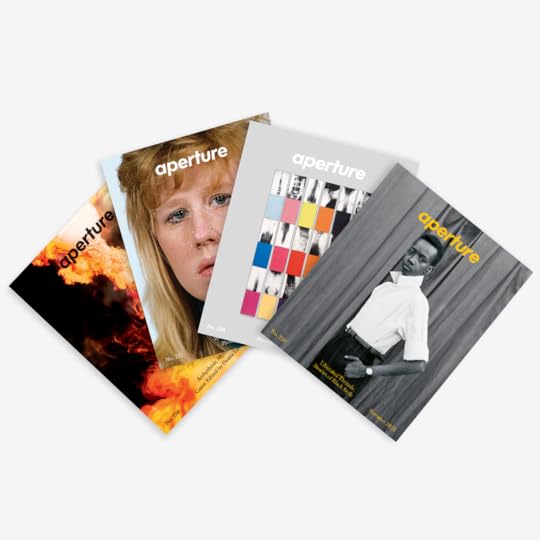 Aperture Magazine Subscription 0.00 Get a full year of Aperture—the essential source for photography since 1952. Subscribe today and save 25% off the cover price.
[image error]
[image error]
Aperture Magazine Subscription 0.00 Get a full year of Aperture—the essential source for photography since 1952. Subscribe today and save 25% off the cover price.
[image error]
[image error] 
In stock
Aperture Magazine Subscription $ 0.00 –1+ View cart DescriptionSubscribe now and get the collectible print edition and the digital edition four times a year, plus unlimited access to Aperture’s online archive.
Although he is now celebrated as one of the most accomplished photographers of the twentieth century, Keïta remained largely unknown in the West until the early 1990s, when some of his photographs (uncredited at the time) that were shown at an exhibition in New York came to the attention of the French curator André Magnin. This set in motion a mission to Mali to find Keïta and introduce his extraordinary portraiture—consisting of thousands of images—to a global audience. Others, including the photographers Bernard Descamps and Françoise Huguier, who presented his work at Les Rencontres d’Arles and at the Bamako Biennale, would also help introduce the work to new audiences.
This success has not, however, come without controversy. Some have questioned the commercialization of Keïta’s portraits, and the way their deep cultural ties to Mali are often diminished when framed for the Western art market, a debate that, in turn, connects to broader issues of appropriation and exploitation of African art within global networks. In Keïta’s case, his prints were upsized, from their original, modest dimensions of 5-by-7 inches, for the contemporary market and an imagined clientele purchasing art at blue-chip galleries like Gagosian and Sean Kelly. An illuminating 2006 article in the New York Times by Michael Rips outlined the multipronged, dramatic saga and litigious debates around the authenticity of some editions produced after Keïta’s death.
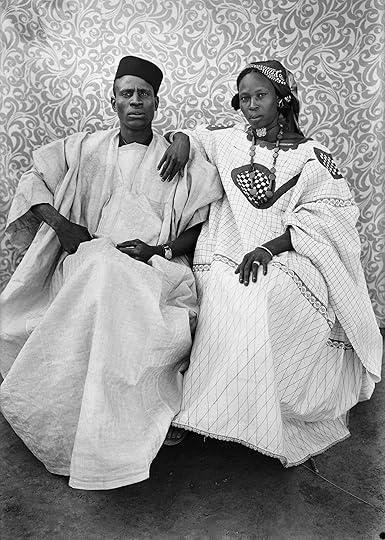 Seydou Keïta, Untitled, ca. 1954–57
Seydou Keïta, Untitled, ca. 1954–57 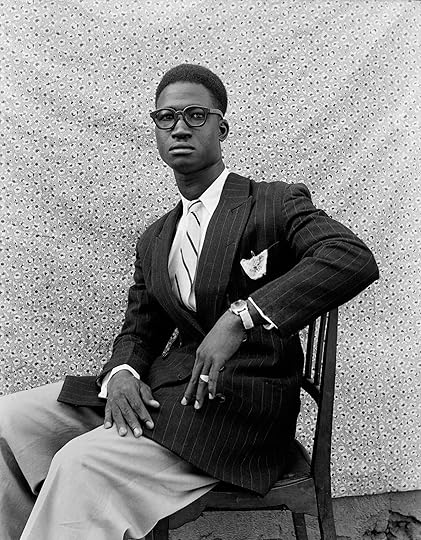 Seydou Keïta, Untitled, 1958
Seydou Keïta, Untitled, 1958 This fall, the Brooklyn Museum, in New York, will hold an exhibition that represents an opportunity to once again assess Keïta’s contributions. The show aims to situate Keïta’s genius within its cultural and historical context, and to highlight his family’s role in preserving his legacy. Catherine McKinley, author of The African Lookbook: A Visual History of 100 Years of African Women (2021), is curating the exhibition. When I spoke with her last winter, she explained that it will allow visitors to immerse themselves in Keïta’s world. His photographs will be displayed alongside textiles and ephemera loaned from the archives of numerous contemporary Malian and Senegalese scholars, collectors, and designers. Highlights include an intricately hand-stitched indigo camisole from 1902 and a women’s pagne (wrapper) from the Musée de la Femme Henriette-Bathily in Dakar that almost perfectly replicates one seen in his pictures.
Unsurprisingly, his work, with its precision and exquisite clarity, has drawn comparisons to August Sander’s portraits made in Germany in the early twentieth century. Keïta’s photography is likewise rooted in the culture and currents of its time. “Keïta crafted a distinctive modernist photographic language anchored in the Malian arts of textile,” Giulia Paoletti, associate professor of African art at the University of Virginia, told me. The cultural and economic forces shaping Keïta’s work were deeply diverse and intertwined. Jennifer Bajorek, an associate professor specializing in literature, art, and visual studies in contemporary Africa at Hampshire College, added that “his photographs bear witness to longstanding histories of trade, trade routes, and zones of cultural and economic exchange. They reveal and carry counter-colonial geographies. This is part of their extraordinary legacy.”
Keïta’s images offer windows into a world where individuals claim space within a rapidly shifting society.
Bajorek is critical of earlier scholars’ preoccupation with whether the textiles in Keïta’s photographs were African or European, given the many cultural currents these objects embody. By way of example, she points to the sanu koloni gold choker worn by many women who went to Keïta’s studio. Its name—meaning “colony gold” in Bambara, a language spoken across Mali—acknowledges its colonial ties. Yet its cruciform shape and five raised points reflect Maure and Amazigh designs, with jewelry historians tracing its craftsmanship and aesthetics to Jewish goldsmiths from the Maghreb, whose techniques and motifs influenced adornment traditions across the region. Bajorek noted that items such as sanu koloni and koso walan—a dark-blue-and-white checkered strip-woven blanket often seen as a backdrop or mat in Keïta’s pictures—possess both colonial history and cross-cultural influences. “A community’s relationships to indigo and indigo-dyed textiles, the protective properties of the number five, the influence of Islam, ideas of Blackness associated with gold, the spiritual as well as material legacies of a millennium of Saharan crossings—all of this is there and, in its way, visible or traced in the photographs made by Keïta in his Bamako studio,” Bajorek said.
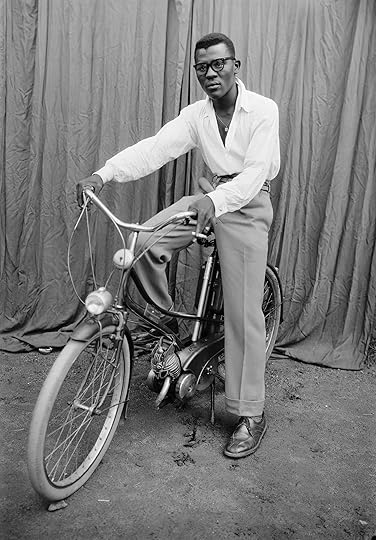 Seydou Keïta, Untitled, ca. 1952–55
Seydou Keïta, Untitled, ca. 1952–55  Seydou Keïta, Untitled, ca. 1952–55
Seydou Keïta, Untitled, ca. 1952–55 More recent history and events have hampered ongoing studies and engagement with Keïta’s pictures and legacy. In the spring of 2024, McKinley traveled to Mali to meet with the Keïta family as part of her research. But with the ongoing conflict in Mali—which began in 2012, when northern insurgents sought independence—she extended her search beyond the country’s borders, delving into archives and collections within the large Malian communities of Dakar and Saint-Louis in neighboring Senegal to gather the pieces that will help bring Keïta’s work to life in the upcoming exhibition.
With its stronger colonial ties and more urbanized infrastructure, Senegal’s long tradition of studio photography dates as far back as 1859. In contrast, Mali’s first studio was established by the Frenchman Pierre Garnier in 1935. Garnier trained several of Mali’s earliest photographers, including Dembélé, but it would take another decade before they would start producing their own studio photographs, opening the door for others, such as the legendary Malick Sidibé, who looked up to Keïta and called him “the Elder.” Keïta’s formal studio portraits not only capture the elegance and aspirations of post-colonial Mali, but also reflect the growing desire for independence, eventually achieved in 1960. In contrast, Sidibé’s candid nightlife photography, which flourished in the 1960s and 1970s, conveys the energy and popular culture of a nation embracing its newfound freedom. Together, they paint a dynamic portrait of a country in flux.
Advertisement
googletag.cmd.push(function () {
googletag.display('div-gpt-ad-1343857479665-0');
});
Mali’s relatively late start in photography turned out to be a blessing, allowing its photographic culture to develop with greater freedom from the colonial conventions that defined Senegal’s numerous, more formal studios. Keïta was arguably the first Malian photographer to fully embrace this freedom. So formidable was his craft and reputation that in 1962 he was appointed Mali’s official state photographer. The arc of his career was punctuated by the progression of Mali’s history, all the way from how his portraiture mirrored the high cosmopolitan hopes that followed the country’s independence, to the military junta that pushed him into retirement in 1977 at the age of fifty-six. At this point, Keïta started pursuing his second passion: auto mechanics. Moving from photography to working on cars may sound like quite a switch, but it had been a passion of Keïta’s before his uncle put the Kodak in his teenage hands. It afforded him a more sedate life, away from the politics of the time. Having been originally trained in the family business of carpentry and furniture making, Keïta had always been a man of his hands. McKinley sees a kind of consistency here: “He was a real technical guy. He liked to tinker and learn and take things apart completely and reconstruct them. That was kind of his nature. He did it with cars, he did it with cameras and everything.”
Keïta died in Paris (where he had traveled for medical attention) in 2001 at the age of eighty. Today, the Bamako property his father gave him can still be found with his family’s name hanging from its tall wrought-iron gate. His legacy within Mali remains strong, with his prints found in places such as the Musée National du Mali, which showcases the country’s cultural heritage and history through an exceptional collection of traditional and contemporary art, including sculptures, textiles, historical artifacts, and photography by the likes of Keïta, Sidibé, and others. “Keïta is widely revered in Mali today,” said Antawan I. Byrd, a photography curator at the Art Institute of Chicago who has worked in Mali. “And his legacy is affirmed through symbolic gestures such as the Grand Prix Seydou Keïta Award, the top prize given at the Bamako Encounters Biennial of African Photography. Yet, despite the international visibility and acclaim his photography has rightfully achieved, Keïta remains, in many ways, a mythologized figure. There is still much to explore and critically examine about his practice.”
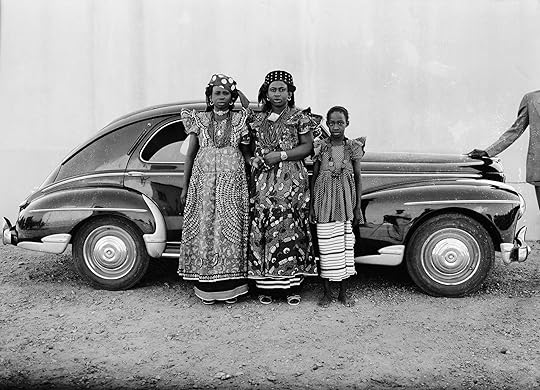 Seydou Keïta, Untitled, ca. 1954–60
Seydou Keïta, Untitled, ca. 1954–60 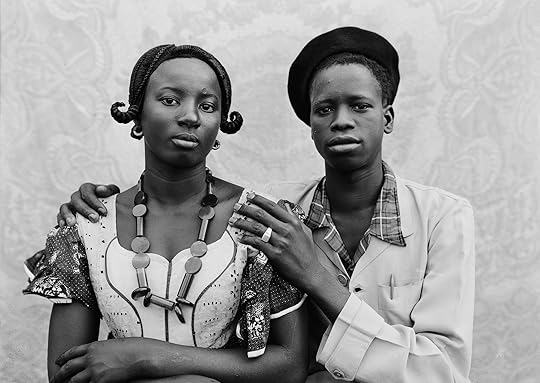 Seydou Keïta, Untitled, 1949
Seydou Keïta, Untitled, 1949All photographs © SKPEAC/the estate of Seydou Keïta and courtesy The Jean Pigozzi African Art Collection
This mythologization stems in part from how Keïta’s work has been understood within global art circles as a singular, almost omniscient eye of post-colonial Mali, widely celebrated yet often removed from the complexities of his working conditions, the commercial nature of his practice, and the broader photographic landscape of Bamako at the time. As a studio photographer, Keïta primarily responded to the needs of his clients, creating portraits that reflected their aspirations in a season of change. Unlike many modernist photographers in the West, he did not fetishize authorial control, and likely considered himself both a craftsman and an artist. While shaping images to meet demand, he was acutely aware of the times in which he lived but may not have consciously curated the legacy he has left behind. Over time, Keïta’s work has been imbued with layers of meaning—revered as both documentary and art—even while it is sometimes unmoored from its original context, a recurring problem in the circulation of African photographic archives.
Keïta’s images offer windows into a world where individuals claim space within a rapidly shifting society. They are living archives, constantly being reinterpreted through contemporary perspectives. They show the enduring power of photography to capture more than mere aesthetic. In contrast to the colonial photography that came before Keïta, which presented the African as mere object, his subjects gaze directly into the camera and claim their place in history on their own terms. Yet his work endures as not only a quiet defiance of colonial narratives but a testament to his mastery. His images do more than resist; they honor, elevating each subject with a care so profound that their presence, etched by Keïta into history using shadow and light, feels both intimate and monumental.
This article originally appeared in Aperture No. 259, “Liberated Threads.”
Aperture's Blog
- Aperture's profile
- 21 followers



